This report is also available in pdf format. Download it here
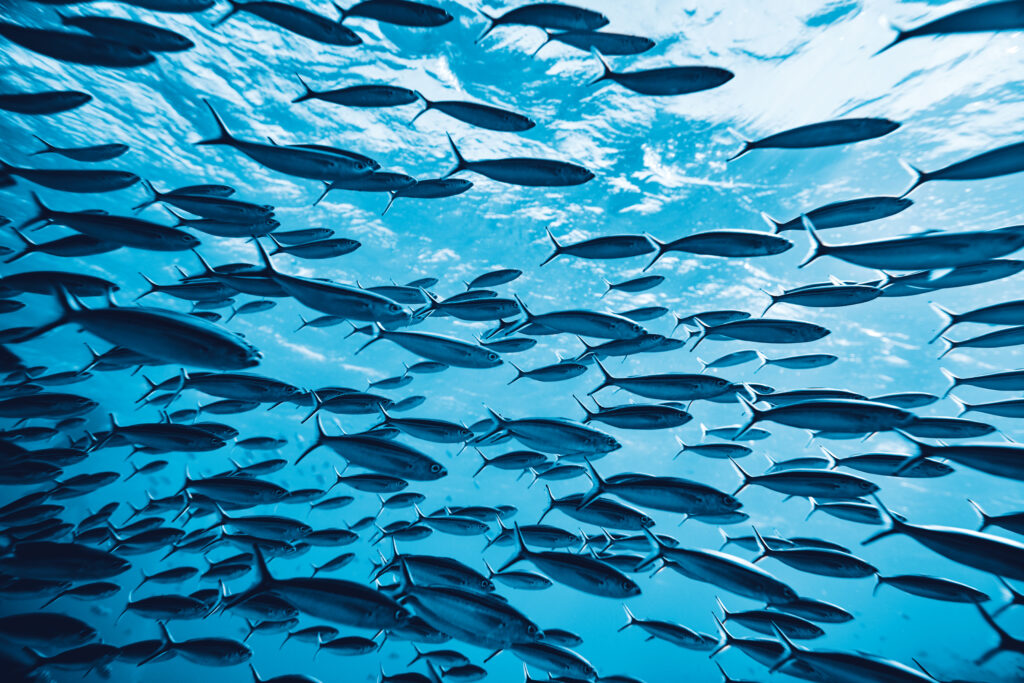
Can we Bring the Oceans Back from the Brink?
Contents
- Paradise almost lost: from infinite, wild, and inexhaustible to finite, fragile, and filled with garbage
- There be monsters: climate-related earth system tipping points and the global ocean
- Speeding into a bright blue future: the blue acceleration, the Anthropocene ocean and the blue economy
- A blue food future: can blue foods support a shift toward a sustainable, healthy food system?
- Marine Plants: the Swiss army knife of the ocean and a key to the future of our food system
- Novel entities & new challenges: welcome to the world of plastic beaches, the reign of jellyfish, adaptable invaders, and metal-tainted tuna
- The deep ocean, the twilight zone and the high seas: the final frontiers of the final frontier
- Anticipating the future of our ocean: unpredictability, conflict, collaboration, and imagination. What happens when we jump off the precipice and cast ourselves into the future?
Share this article
“How inappropriate to call this planet Earth when it is quite clearly Ocean.”
– Arthur C. ClarkeThe ocean is truly the final wild commons. We should support its ability to deliver ecosystem goods and services and remain a cornerstone of the global food system far into the future.
Yet, we mistreat, exploit and pollute it. We take it for granted, without grasping how vulnerable it actually is. This was made abundantly clear on May 25 when a cargo ship carrying numerous tons of toxic chemicals caught fire and sent flaming containers of nitric acid, sodium hydroxide, and plastic pellets into the sea, just 14 km from the port in Sri Lanka’s capital, Colombo. The worst maritime disaster in the country’s history is a mortal blow to the region. Hazardous waste, microplastics, burned debris, and dead marine life immediately washed up along the once-pristine shores. Fishing was promptly banned within a 50-mile radius of the wreck, causing devastation to thousands of locals who depend on the industry for their livelihoods.
The MV X-Press Pearl also transported a noxious stew of caustic soda, lubricating oils, aluminium byproducts, lead ingots, ethanol, and epoxy resins. As the ship has now sunk, the risk of these chemicals leaching into the ocean is highly probable, posing severe threats to the ecosystem, which in turn could contaminate and kill corals and sea creatures. The plastic carried aboard will remain in the ocean for decades, polluting coastlines, marine life, and Sri Lanka’s lagoon systems.
“This could be the death of our sea,” predicted the Sri Lankan environmentalist, Nayanaka Ranwella.
Our oceans are ailing, mostly due to human-induced pressure, but they are still remarkably bountiful. To save this potentially endless and sustainable source of nutritious food – the “infinity fish,” as Dr. Rashid Sumaila (Professor and Director of the Fisheries Economics Research Unit at the University of British Columbia Fisheries Centre) calls it – there’s a laundry list of things we must do. We need to protect vulnerable habitats and ecosystems, reduce rates of overexploitation, regulate exploratory fishing, take charge of and steer the development of the blue economy, mitigate greenhouse gas emissions, curtail the flow of pollutants into the ocean, and focus on restoration and nature-based solutions.
Emphasizing this significant agenda, the National Geographic Society officially recognized the world’s fifth ocean on June 8 – World Oceans Day. Surrounding Antarctica, the Southern Ocean is defined by its influence on the world’s weather systems and the Earth’s climate. It does so by circulating immense volumes of ocean water and powering the Antarctic Circumpolar Current (ACC). Pulling water from its neighboring water bodies – the Indian, the Pacific, and the Atlantic Oceans – it contributes to a global circulation system known as the “ocean conveyor belt”, which transports water, and more importantly – heat – around the planet. So the ocean brings warm air and water to areas that would otherwise be much colder or get too warm. It also helps store carbon in the deep ocean as cold, dense water sinks to the ocean floor off Antarctica.
By recognizing the fifth ocean, the National Geographic Society acknowledges that the Southern Ocean plays an important role in keeping the world spinning and the planet’s delicate climate in fair sync.
To commence our exploration of the oceans’ functions within the global food system, we must reflect on the big blue as part of our humanity.
We invite you to take a metaphorical journey some 20+ leagues under the sea to embrace and understand the ocean and our problematic, complex relationship with the same.
Fundamentally, we are the ocean.
“(...) It is an interesting biological fact that all of us have, in our veins, the exact same percentage of salt in our blood that exists in the ocean, and, therefore, we have salt in our blood, in our sweat, in our tears. We are tied to the ocean.”
– Former US President John F. KennedyParadise almost lost: from infinite, wild, and inexhaustible to finite, fragile, and filled with garbage
Humanity has had such an impact on the ocean that we have altered entire ecosystems and even reshaped the fundamental genetic structure of many marine species.
The global ocean – one interconnected, giant body of saltwater made up of five oceanic basins – has gone from infinite, wild, and thriving to finite, fragile, and filled with garbage; oily, hot, acidic, littered with plastic, and a lot emptier.
“Life has existed in the ocean for 3.7 billion years – three times longer than life on land”
Humanity and the ocean are fundamentally interconnected and have been since our common ancestors first climbed out of the primordial waters and stepped onto land. Life has existed in the ocean for 3.7 billion years – three times longer than life on land. Even in our short time on this planet, humans have had a lasting relationship with the ocean, stretching back thousands of years. During the Anthropocene, and especially since the beginning of the Industrial Revolution, humanity has had such a tremendous impact on the ocean that we have altered entire ecosystems and even reshaped the fundamental genetic structure of many marine species.
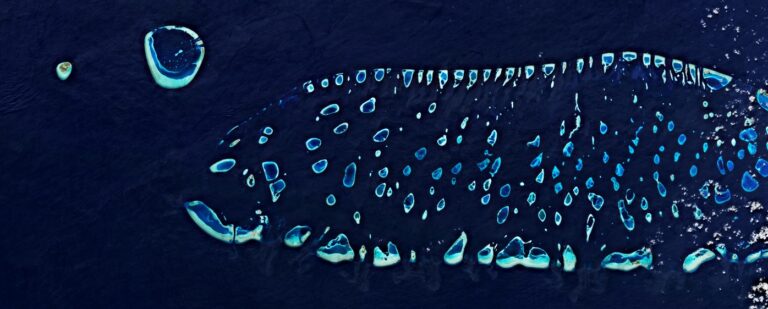 Ari Atoll, Maldives. One of the world’s lowest-lying countries; more than 80% of the Maldives’ land is less than one meter above average sea level. This extremely low elevation makes the country and its inhabitants particularly vulnerable to sea-level rise. Photo: ESA
Ari Atoll, Maldives. One of the world’s lowest-lying countries; more than 80% of the Maldives’ land is less than one meter above average sea level. This extremely low elevation makes the country and its inhabitants particularly vulnerable to sea-level rise. Photo: ESA
The global ocean covers 71% of the earth’s surface, yet we have explored perhaps 5% of it. Even today, after extensive observation, experimentation and study, the ocean remains more of a mystery than a known quantity. It is a commonly quoted fact that, by some measures, we have explored more of space than we have of the oceans. After all, since 1969, we have sent 12 humans to the moon, yet only three people have descended to the deepest part of the ocean, the Marianas Trench. Yes, space is endless compared to the ocean, but the ocean is still enormous.
For many communities worldwide, the ocean is a source of social, cultural, and legal identity, providing a deep-seated sense of place. It inspires spirituality and nourishes physical and mental health. However, for many of these communities, the ocean has now become an existential threat as sea levels slowly rise and ecosystems come under more and more pressure.
We are doing an excellent job of degrading and impacting a vast system that provides the oxygen for every second breath we take, a system that sequesters 25% of the carbon emissions we produce, provides nutritious sustenance, livelihoods, and economic value. It has been estimated that if the ocean were a country, its economic output would rank it as the 7th largest in the world. The value and benefits the ocean provides are inextricably linked to the stress we put on it and the damage we cause. But it would be very myopic to focus only on the ocean as a provider of tangible, monetary benefits to humanity.
Recently, the popular but controversial Netflix documentary Seaspiracy shed light on the many problems associated with the global fishing industry and our efforts to harvest the oceans. Although this helps raise awareness, it ignores the complexity of humanity’s relationship with the ocean and its importance for our past, present, and future development. The simple, seductive message – Stop eating fish! – is not realistic. It would be actively damaging for millions of people who depend on coastal fisheries – many of whom also face poverty, hunger, and malnutrition.
To grasp the future of the ocean, we must figure out its past
We are now at the crossroads of deciding what relationship between the ocean and people we would like to have for humanity as a whole. When thinking about the future of the ocean and the food system, it is crucial that we draw inspiration from the past and not limit ourselves to the perceived reality of the present.
Retrospective data not only help to clarify underlying causes and rates of ecological change, but they also help establish achievable goals for coastal ecosystems restoration and management. These goals could not even be considered if based on the limited perspective of recent observations alone.
Today, we are comparing current biomass, biodiversity, and species abundance levels against a baseline that has shifted drastically since humans began hunting with technology. Chiefly, this started with whaling in the 1800s and accelerated exponentially during World War II as new technologies developed. Sonar, high-power diesel engines, and synthetic materials such as nylon were used to create modern industrial fisheries equipment, and by extension, a relentless process of “mega-engineered” ocean fisheries.
When diving into the ocean’s past, it is helpful to review coral reef ecologist Jeremy Jackson’s seminal work. Leading a team of scientists, he introduced the concept of “shifting baselines”, coined in 1995 by marine biologist Daniel Pauly as the “Shifting Baseline Syndrome”. Jackson explains his take on the phenomenon as follows:
“Historical abundances of large consumer species were fantastically large in comparison with recent observations. Paleoecological, archaeological, and historical data show that time lags of decades to centuries occurred between the onset of overfishing and consequent changes in ecological communities because unfished species of similar trophic level assumed the ecological roles of overfished species until they too were overfished or died of epidemic diseases related to overcrowding.”
Jackson and colleagues document this shifting baseline across a large number of marine species and ecosystems: from kelp forests to coral reefs to tropical and sub-tropical seagrass beds to offshore benthic communities and estuaries. As humans have expanded from land to oceans, the combination of fishing, pollution, invasive species, the onset of climate change, and mechanical destruction of habitats – mangroves, kelp, seagrass – led to radically altered ecosystems very different from those in the past. They represent a new baseline from which we are considering the human impact on the ocean.
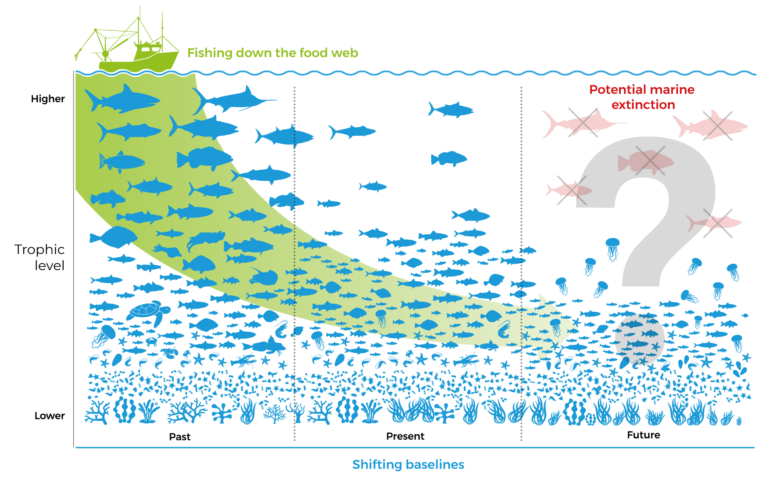 Figure 1: Adapted from Pauly et al. (1998). Fishing Down Marine Food Webs. Science, 279(5352, pp. 860-863 and Jackson et al. (2001). Historical Overfishing and the Recent Collapse of Coastal Ecosystems. Science, 293(5530), pp. 629-637.
Figure 1: Adapted from Pauly et al. (1998). Fishing Down Marine Food Webs. Science, 279(5352, pp. 860-863 and Jackson et al. (2001). Historical Overfishing and the Recent Collapse of Coastal Ecosystems. Science, 293(5530), pp. 629-637.
Globalization of modern fishing
Transnational fishing operations and global supply chain patterns are complex. Cod caught in the Baltic are flash-frozen, sent to China for processing, and then shipped to the U.S. to be eaten as fish fingers by American families.
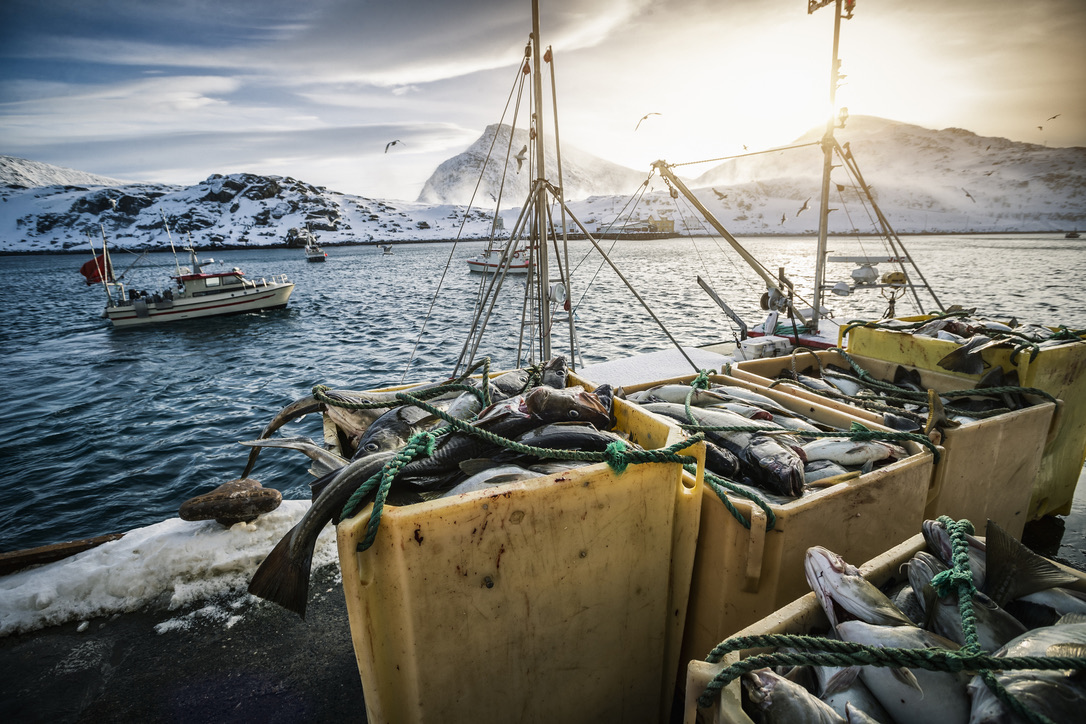 Industrial cod fishing in Norway. Photo: Getty
Industrial cod fishing in Norway. Photo: Getty
“Every year, legally and illegally, humans extract approximately 120 million tons of fish from the ocean. That is more than all the cows we slaughter on our farms, globally”
Humanity faces mounting pressures from numerous different directions as we are prompted to simultaneously preserve, develop, protect, and utilize the ocean. The modern fishing industry’s globalization illustrates the intense reality of humanity’s current use of the ocean. Fishing happens all over the oceans – within the jurisdiction of individual states along the coast and under no state jurisdiction whatsoever many miles from shore.
Transnational fishing corporations connect marine ecosystems worldwide through complex, constantly adapting supply chains, providing consumers in Western Europe with fish from West Africa. Cod caught in the Baltic are flash-frozen, sent to China for processing, and then shipped to the U.S. to be eaten as fish fingers by American families. Schools of anchoveta off the coast of Peru are turned into fishmeal by a Chinese-owned Peruvian company and used as a component in feed to raise farmed salmon in massive operations controlled by Norwegian corporations with subsidiaries in Chile.
Marine ecosystems themselves add layers of complication to any governing attempts. Fish move; they cross boundaries without consideration for national borders or carefully agreed on catch quotas; some migrate thousands of kilometers and might be caught just before they breed. Each species possesses its own unique habit, and many of them are sensitive to the processes of environmental change that affect the oceans, including elevated temperatures and climate-induced ocean acidification.
Humans extract approximately 120 million tons of fish from the ocean every year, both legally and illegally. In borrowing another metaphor from Dr. Rashid Sumaila, if you convert this to mature cows weighing roughly one ton each, then 120 million fully grown cow-fish are taken out of the ocean yearly. That is more than all the cows we slaughter on our farms globally. And many of those cows are fed with animal feeds containing ground ocean fish.
 Figure 2: Estimates of total industrial, artisanal, subsistence and recreational catch between 1950 and 2010. The dotted line indicates reported global fish catch. Adapted from Pauly, D., & Zeller, D. (2016). Nature Communications.
Figure 2: Estimates of total industrial, artisanal, subsistence and recreational catch between 1950 and 2010. The dotted line indicates reported global fish catch. Adapted from Pauly, D., & Zeller, D. (2016). Nature Communications.
Rising pressure on marine biodiversity might soon rival that on land
“Over the last 500 years, there have been around 500 documented extinctions of terrestrial species, but only 15 documented marine extinctions. But the deep may conceal big dark numbers”
There has been a dramatic collapse in the abundance of many of the fish populations that humans eat. We overexploit more than three-quarters of fish stocks for which we have data, placing hard limits on our potential for extracting food from the ocean. A pattern of “fishing down the food web” has also been detected as heightened demand for seafood has led to fishing down from large predatory fish to krill and beyond.
 Figure 3: Graph showing global patterns of fisheries exploitation. 'Maximally sustainably fished' is disputed by many scientists and many argue that many of these fish stocks are also overexploited. Adapted from FAO (2018).
Figure 3: Graph showing global patterns of fisheries exploitation. 'Maximally sustainably fished' is disputed by many scientists and many argue that many of these fish stocks are also overexploited. Adapted from FAO (2018).
Overexploitation – the direct fishing pressure humans place on the marine environment – is the primary driver of biodiversity loss. It is made worse by related human pressures such as development, pollution, habitat loss, and various kinds of disturbances, mainly in densely populated coastal environments.
Currently, circa 60% of the world’s population lives no further than 60 km from the coast. In the next two decades, that population is expected to grow to approximately 75%, even as sea levels are rising, prompting migration from today’s heavily populated coastal areas.
Increasingly, climate change and ocean acidification will drive biodiversity loss and cripple sensitive coastal ecosystems. Some species will dwindle considerably; others will be pushed to undergo “range shifts”, tracking new ecological niches through migration. One highly influential study, led by Canadian Professor William W.L. Cheung, states that, locally, in sub-polar regions and the tropics, climate change could lead to “dramatic species turnovers of over 60% of current marine biodiversity.”
Yet, there remains some good news if we compare the ocean to terrestrial systems. So far, the sixth mass extinction has been chiefly happening on land. Douglas McCauley, Professor of Ocean Science at the University of California Santa Barbara, estimates that, over the last 500 years, there have been around 500 documented extinctions of terrestrial species, but only 15 documented marine extinctions.
“Because fewer extinctions have occurred in the ocean than on land, humans have more to work with when restoring marine ecosystems. Even a modest release of pressure will allow the ocean’s incredible resilience to kick in”
Determining true verification of extinction is much more difficult in the ocean because of its size and the sheer difficulty in researching it. McCauley notes that it took us 73 years to find the Titanic – a gigantic steamship – so it is not hard to understand why some extinctions may have been missed. Most at risk are species that cater to humanity’s voracious appetite for marine protein. Sharks and rays (cartilaginous fish) also swim in the danger zone as they are often caught as bycatch and unfortunately breed less and grow slower than bony fish species.
Because fewer extinctions have occurred in the ocean than on land, humans have more to work with when restoring marine ecosystems. Even a modest release of pressure will allow the ocean’s incredible resilience to kick in and ecosystem-level recovery processes to begin. Take this excellent example: new scientific work shows how ceasing commercial whaling sparked the recovery of baleen whales, leading to a significant spike in nutrient recycling (more whales means more nutrient-rich whale poop) in the Southern Ocean. The scientists make the compelling argument that the return of this crucial species could support increased ocean productivity and make up for the loss of ecosystem function caused by the past century’s voracious and devastating whale hunting.
Encouragingly, numerous ocean species still cover roughly the same ranges and can be found in many of the same places as hundreds or thousands of years ago, making a recovery more viable.
McCauley puts forward the example of the Asian tiger in his study “Animal loss in the global ocean”. It has suffered a loss of 95% of its roaming range due to human habitat encroachment. The tiger shark, by contrast, maintains almost all of its range even though its numbers have been severely depleted. However, this picture is somewhat complicated by projected climate-induced range shifts of many species. Historical ranges of marine species may also prove untenable in the face of warmer, more acidic, and deoxygenated waters.
The hunt for ocean space beyond coastal zones has begun in earnest. But this quest for new territories and the resources that occupy them must be well-considered and flawlessly managed and executed. So far, indications are the opposite. We stand at an ocean frontier that compares to the point at which, on land, the pace of extinctions accelerated rapidly.
There be monsters: climate-related earth system tipping points and the global ocean
Ocean warming has alarming consequences for marine ecosystems and the future role of the oceans as an essential component of the global food system.
“Between 1970 and 2010, the ocean absorbed 93% of the extra heat caused by global warming. The other 7% was distributed in the atmosphere and over land and has been the cause of ice melt”
The global ocean plays a central role in regulating the global climate system and mitigating climate change. It has been instrumental in limiting the rise in temperatures driven by anthropogenic climate change thus far. Indeed, the ocean has absorbed the absolute largest amount of extra heat accumulated in the earth system, due to its immense volume and the natural heat absorption qualities of seawater. Between 1970 and 2010, the ocean absorbed 93% of the extra heat. The other 7% were distributed in the atmosphere and over land, causing ice melt.
But taking in this extra heat was costly. Man-made climate change is altering both atmospheric and oceanographic conditions that regulate marine systems. The ocean itself is now warming, not only on the surface but also through the deeper layers. There has been documented warming of the abyssal ocean (below 4000m) in the Southern Hemisphere, causing long-term and largely irreversible warming of water temperatures. Very recently, a gigantic ice shelf about 80 times the size of Manhattan sloughed off Antarctica; it was anointed the world’s largest iceberg. Arctic summer sea ice is rapidly becoming a pre-Anthropocene relic. All of this unprecedented ice melt is feeding sea-level rise.
The quiet crossing of marine tipping points
“Ocean acidification is a slow-moving, incremental tipping point. When it reaches a certain stage, the oceans’ buildup in acidity could gravely impact shellfish and other calcifying organisms and those relying on them further up the food chain”
Recent research has focused on evidence for climate-related earth system tipping points. As put forward in the planetary boundaries framework, if these tipping points are crossed, we would move well past the “safe operating space” for humans to flourish on a resilient planet. Thus far, oceans and coasts have not been especially well incorporated into the planetary boundaries framework.
However, there is mounting evidence that many of the potential earth system tipping points are directly or indirectly linked to the oceans – ranging from high and low impact to high and low probability. For example, the potential collapse of the global ocean overturning circulation and/or the rapid collapse of the West Antarctic ice sheet are both considered to be tipping points of low probability (will most likely not occur before 2100) but, they will have a very high impact, if and when they do.
Although slow-moving and incremental, ocean acidification is a high impact, high probability tipping point. When it reaches a certain stage, the oceans’ buildup in acidity could gravely impact shellfish and other calcifying organisms and those species that rely on them further up the food chain. The effects of acidification are already being felt in the ocean.
Newly published work entitled “The quiet crossing of ocean tipping points” underlines the need to consider the implications of combined ocean tipping point developments rather than examining them as isolated occurrences; for example, the deadly dangerous, linked impacts of ocean warming, acidification, and deoxygenation on marine ecosystems. The authors point out that many extreme events are now occurring with increasing frequency. As on land, they transcend the large-scale changes to ocean “state variables” and include coastal hypoxia (low oxygen levels) and heatwaves, like those that afflict and devastate the Great Barrier Reef.
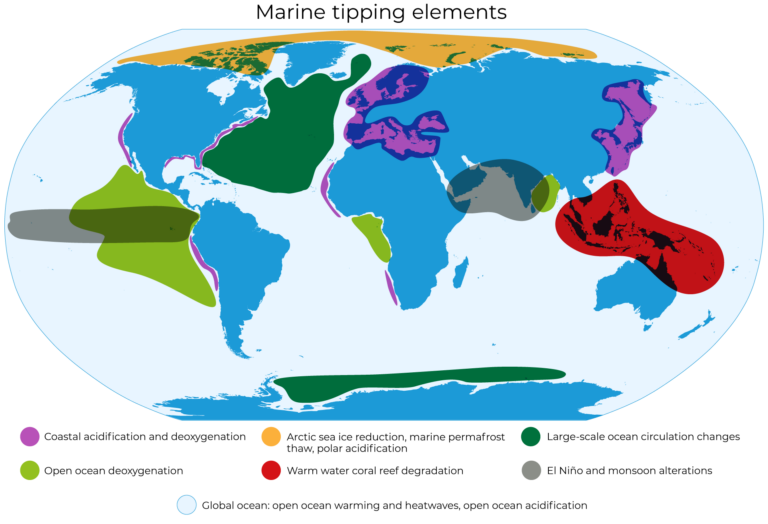 Figure 4: Potential climate-related ocean tipping points. Adapted from Heinze et al. (2021). 'The Quiet Crossing of Ocean Tipping Points.' PNAS.
Figure 4: Potential climate-related ocean tipping points. Adapted from Heinze et al. (2021). 'The Quiet Crossing of Ocean Tipping Points.' PNAS.
Ocean warming and marine heatwaves
“The most infamous marine heatwave thus far occurred in the Northeast Pacific Ocean in 2013-2016. Known as “the blob”, it stretched 1600 km with water temperatures six degrees Celsius above average”
Marine heatwaves, primarily driven by El Niño events, offer a good example of how climate change is altering the ocean in ways that were previously deemed unthinkable. How could human activity possibly affect such a vast system?
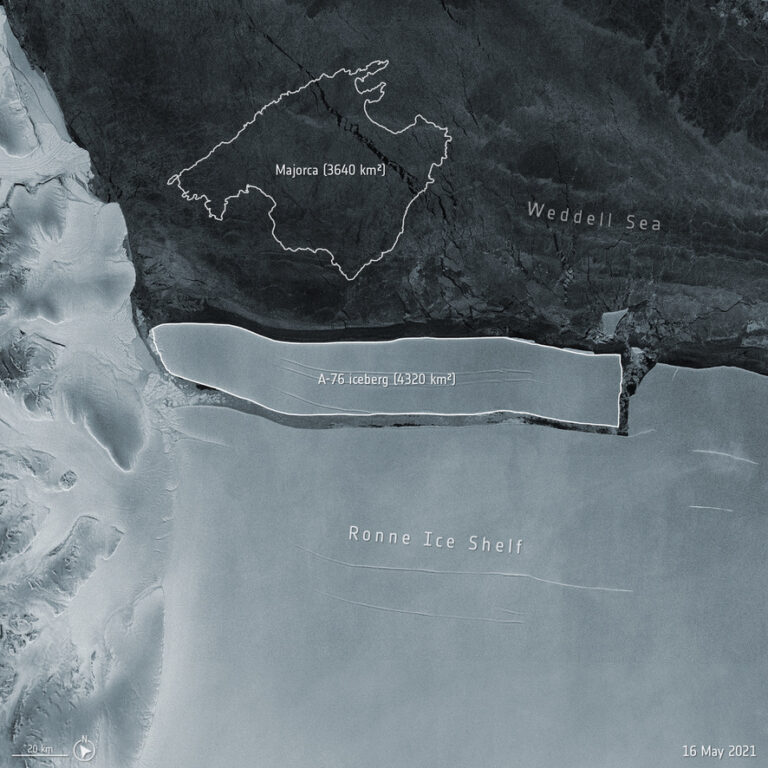 An enormous iceberg has calved from the western side of the Ronne Ie Shelf, lying in the Weddell Sea, in Antarctica. The iceberg, A-76, is now the largest berg in the world, slightly larger than the Spanish island of Majorca. Photo: ESA
An enormous iceberg has calved from the western side of the Ronne Ie Shelf, lying in the Weddell Sea, in Antarctica. The iceberg, A-76, is now the largest berg in the world, slightly larger than the Spanish island of Majorca. Photo: ESA
Heatwaves have previously been studied on land, but only recently have they been considered in the context of the ocean. Yet, over the last decade, they have been observed in all five ocean basins. The most infamous marine heatwave thus far occurred in the Northeast Pacific Ocean in 2013-2016. Known as “the blob”, it stretched 1600 km with water temperatures six degrees Celsius above average. The duration of marine heatwaves has doubled since 1982, and they are increasing in length, intensity, and size.
 Figure 5: Marine Heatwaves. Adapted from Frölicher, T.L. (2019). Extreme Climatic events in the Ocean. Chapter 5 of 'Predicting Future Oceans.'
Figure 5: Marine Heatwaves. Adapted from Frölicher, T.L. (2019). Extreme Climatic events in the Ocean. Chapter 5 of 'Predicting Future Oceans.'
Ocean warming has alarming consequences for marine ecosystems and the future role of the oceans as an essential component of the global food system. Warm water corals have so far been the most profound victims of these heatwaves as they are extremely sensitive to higher ocean temperatures. Coral reefs are immensely productive, biodiversity-rich marine ecosystems, making their damage particularly devastating. A prolonged marine heatwave from 2014 to 2017 caused mass coral bleaching; it is the third global-scale bleaching event in the last two decades.
So-called “heat stress” from this event bleached 75% of the corals and caused the death of 30% of the symbiotic organisms that are the living parts of coral reefs. In November of 2018, a grim world record was reached when Australia’s Great Barrier Reef warmed to a temperature of 42.6°C, which beat an earlier record, set in 1900, by nearly six degrees. Leading coral reef scientist, Professor Terry Hughes, commented: “We were really shocked. No scientist expected to see three severe bleaching events in just five years.” There are some signs that coral reefs are adapting to increased water temperatures, as entire ecological structures on the reefs are changing, and heat-resistant species are thriving.
The question, however, is whether the speed of adaptation will be able to outpace the accelerating pace and increasing volatility of human-caused climate change. Aside from general efforts to mitigate climate change, CRISPR gene-editing technology, and newly emerging biotechnologies are being utilized to boost “facilitated adaptation” of marine species, supporting genetic traits that allow species to cope with higher temperatures. For example, early-stage experiments are being conducted with CRISPR technology to support coral conservation efforts.
Of course, heatwaves are not only impacting coral reef ecosystems. Reported biological impacts on other ecosystems range from geographical species shifts and widespread changes in species composition to harmful algal blooms, mass stranding of mammals such as whales and dolphins, and mass mortalities of particular species of fish. Stationary species that cannot move to cooler waters are especially vulnerable and will need extra care to avoid being severely degraded or even wiped out as climate change continues to advance into the oceans.
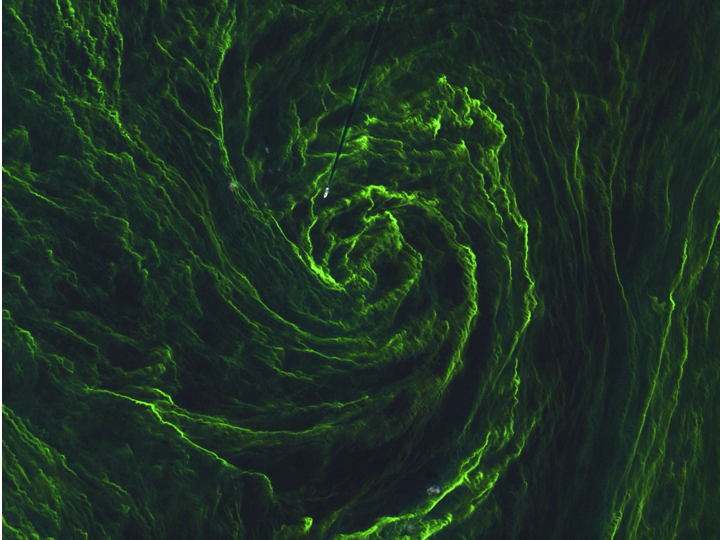 Algal Bloom in the central Baltic Sea, captured by the Sentinel-2A satellite. Photo: ESA
Algal Bloom in the central Baltic Sea, captured by the Sentinel-2A satellite. Photo: ESA
Overall, in some parts of the ocean, climate change could cause an approximate 20% decline in ocean productivity and associated marine animal biomass. The historical abundance and resilience of the oceans – taken for granted and largely ignored by humans – could be irreversibly damaged.¨
Speeding into a bright blue future: the blue acceleration, the Anthropocene ocean and the blue economy
“If we want to find a starting point for thinking about the oceans as a source of food, it is important that we start on land”
How the trajectory for oceanic development will play out from now on depends on how humanity acts upon different alternatives. There is an evidence-backed perception that land-based food sources, materials, and space are either expiring or wholly exhausted. This makes it tempting to see the ocean as the next “exploitation frontier.”
For numerous powerful actors, the ocean promises opportunities to extend many of the lucrative but environmentally ruinous processes they have used on land. The ocean would then risk resembling the dominant terrestrial, industrial food system shaped by intensive agriculture. Yet, there is a widespread belief that, despite what happened on land, things will work out better in and on the ocean; economic development will be more sustainable. More specifically, the narrative is that the blue economy can get “right” what we got “wrong” on land. There is an expressed aspiration that the blue economy should be not only an engine of sustainable development – it should also further equitable development. This argument is made in recent work by researchers at the Stockholm Resilience Centre: The Blue Acceleration – The trajectory of human expansion into the global ocean. In this report, the authors define the ongoing blue acceleration as follows:
“Claiming the ocean for food, material, and space is not new to humanity, but the current rush for the ocean is unfolding with unprecedented diversity and intensity. We describe this as the blue acceleration, a new phase in humanity’s relationship with the biosphere, where the ocean is not only crucial for sustaining global development trajectories but is being fundamentally changed in the process… The acceleration of different industries and interests into the ocean is not only leading to an intensification of pressures but is also setting up a range of synergistic, antagonistic and additive interactions between the various claims for food, space, and materials.”
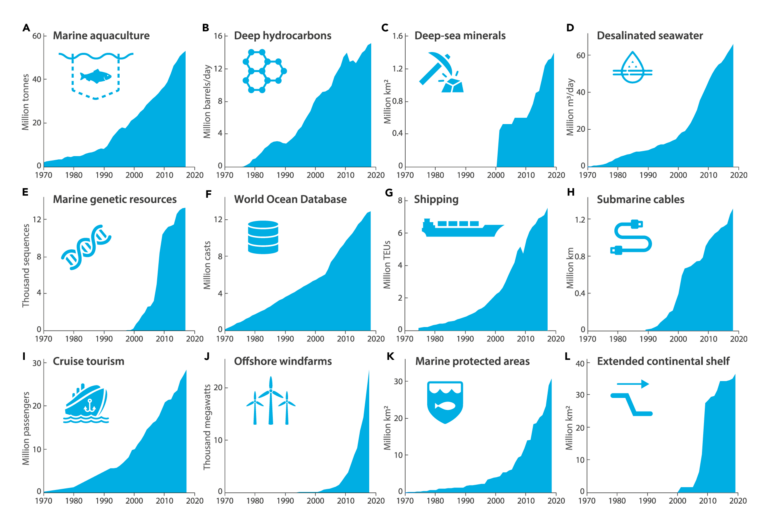 Figure 6: The Blue Acceleration. Adapted from Jouffray et al. (2020). 'The Blue Acceleration: The Trajectory of Human Expansion into the Ocean. One Earth.
Figure 6: The Blue Acceleration. Adapted from Jouffray et al. (2020). 'The Blue Acceleration: The Trajectory of Human Expansion into the Ocean. One Earth.
A highly illustrative example of what the blue acceleration looks like from this recent work, in terms of colliding interests and the acceleration of ocean-based economic activities, can be told through the story of a humble sea snail species. The Scaly-foot snail (Chrysomallon squamiferum) was first discovered in 1999, named in 2015, and placed on the IUCN Red List of threatened species in 2017. It was found more than 2,400 meters beneath the ocean on only three deep-sea hydrothermal vent systems covering an area of 0,02 km2, in a locality where the International Seabed Authority (the body that covers any claims on the seabed) has granted exploratory mining licenses.
This little snail is unique as it is the only known creature to use iron sulfides to construct its skeleton, and once its processes are understood, many of its unique characteristics could be mimicked in the development of biotechnology or materials technology. Indeed, the U.S. Department of Defense is already trying to “bio-mimic” the scaly-foot snail to develop a new generation of body armor.
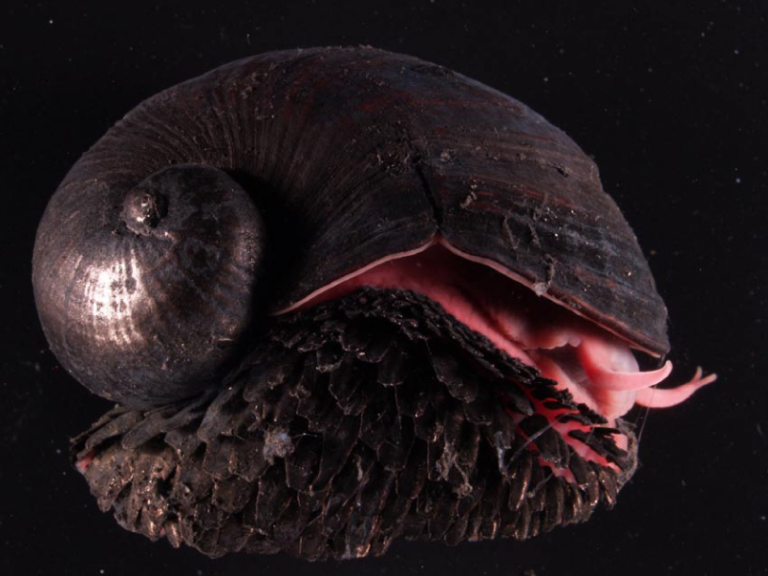 The Scaly-foot snail, Chrysomallon squamiferum – a unique species with a unique construction with three layers. Known as the pangolin of the sea, this is one of the most metal animals on Earth. Photo Credit: Kentaro Nakamura at al. PLoS ONE 7(3): e3296
The Scaly-foot snail, Chrysomallon squamiferum – a unique species with a unique construction with three layers. Known as the pangolin of the sea, this is one of the most metal animals on Earth. Photo Credit: Kentaro Nakamura at al. PLoS ONE 7(3): e3296
While these exploratory deep-sea mining licenses were granted, nearly 120 sequences from the Scaly-foot snail genome were registered in Genbank, an open-access database of nucleotide sequences serving as a reference point for the biotech industry.
Because of the placement of claims and the complexity of territorial boundaries, within five years, the survival of the Scaly-foot snail moved from a responsibility of the global community to the responsibility of three countries: China & Germany (the countries granted exploratory mining licenses) and Mauritius (one of the hydrothermal vent systems is located within the exclusive economic zone of Mauritius). The case of the iron-shelled sea snail illustrates both the unexpected opportunities and the many potential conflicts that hide in the deep. This unique snail further illustrates how the conflicts and opportunities that the blue economy represents are not unique to coastlines; they also extend to the most remote parts of the ocean. Within just a few years, geopolitics, biotechnology, deep-sea mining, conservation, contrasting governance regimes, and a newly discovered species all came crashing together in a tiny space over a very short period of time. It is the blue acceleration exemplified in less than 1 km2, far offshore, away from any humans.
The emergence of a novel ocean economy
“A once-popular view that the ocean, unlike the continents, was simply too big to be affected by human actions has been replaced by the reality of the Anthropocene Ocean, in which the ocean is neither ‘too big to fail, nor too big to fix, it is too big to ignore.’”
- Jane Lubchenco & Steven Gaines, A new narrative for the ocean, Science, 7 June 2019.Part of the blue acceleration’s big picture makes it clear that, when it comes to the oceans, we are now approaching the same point we reached with land hundreds of years ago – saturation, recognition of limits, conflict, competition, and other emerging problems caused by the proximity of diverse players interacting with ecosystems and operating as part of a global economy.
Although not on the Top 10 list (spearheaded by China, Indonesia, India, and Vietnam), at #11, Norway is one of the world’s most successful fishery countries, not least when it comes to export, where it has claimed the #2 spot. It provides ample illustrations of how densely populated ocean space runs the risk of conflict across industries. Escapee salmon from aquaculture have spread sea lice in wild populations, creating tensions with Norwegian fisheries. Furthermore, accidents in the oil and gas industry could cause significant damage to local seafood and tourism, as well as the seafood export market.
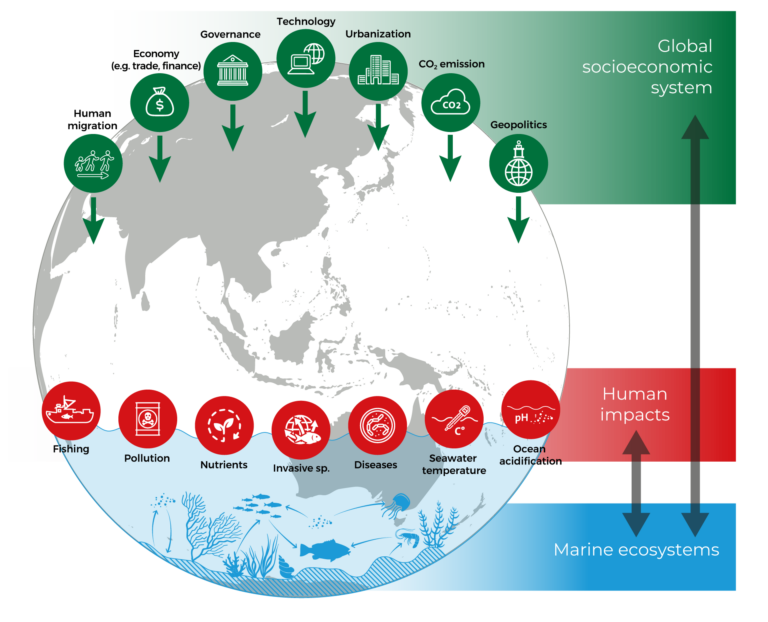 Figure 7: The Anthropocene Ocean. Adapted from Jouffray, J.B. (2020). 'The Anthropocene Ocean.' PhD Thesis
Figure 7: The Anthropocene Ocean. Adapted from Jouffray, J.B. (2020). 'The Anthropocene Ocean.' PhD Thesis
In a recent work led by John Virdin, the authors quantify the industries’ push into the ocean by highlighting the extreme degree of consolidation across relevant industry sectors. First, they identified the ten most prominent companies in each of eight present “core ocean industries”, collectively generating approximately 45% of the total revenue for each industry. They then aggregated this across industry sectors to devise the “Ocean 100” – the 100 companies that account for circa 60% of total revenues across all core ocean industries. Virdin and colleagues argue that this high percentage concentration of companies at the forefront of the ocean economy presents both substantial risks and ample opportunities for ensuring sustainability and equity of global ocean use.
It is worth noting that many of the multinational corporations on the Ocean 100 list are well-established enterprises, representing economic sectors, business models, and worldviews closely wedded to the twentieth-century status quo. Will these business concerns initiate and lead a transformation? Or will they turn the ocean into a facsimile of intensive agriculture, replicating the exploitative, environmentally destructive, and lowest-cost operational models used on land? Things are already heading in this direction, and there is a limited window of opportunity for alternatives to take hold.
Rather than relying purely on existing business entities and new entrants with their own agendas to devise ways of moving toward biosphere stewardship, the responsibility must come from forward-looking and creative regulatory regimes with global jurisdiction.
Avoiding traps at the blue economy frontier
“Artisanal or small-scale fisheries currently account for around 50% of reported wild capture fisheries production and over 90% of employment in the fisheries sector”
An intensely powerful, relentless momentum is driving the push to develop the “ocean economy frontier” – at times bordering on hyper-capitalism and neo-colonialism. But what forces are balancing it? This is, after all, a development push that disregards many users of the ocean; ocean communities, small-scale fishers, indigenous groups, small, developing island states, and others. The “ocean economy frontier” vision also prioritizes marine protein production of high-value species, primarily benefiting the rich world, which risks undermining the food security of those most reliant on nutritious marine protein as a cornerstone of their diets.
The fishing industry must be examined in a global food system context. Artisanal or small-scale fisheries currently account for around 50% of reported wild capture fisheries production and over 90% of employment in the fisheries sector. In West Africa and other parts of the world, industrial fisheries operate alongside small-scale fisheries but are often given much more weight in policy discussions and international negotiations. Yet, small-scale fisheries provide the vast majority of the livelihoods and nutrition for coastal communities in different parts of South and Central America, Africa, and Southeast Asia. As part of the recently launched Blue Food Assessment, postdoc and researcher at the Stockholm Resilience Centre, Stockholm University, Becca Short has led a new study on the role of smallholders in global blue food production.
The World Bank defines the blue economy as the “sustainable use of ocean resources for economic growth, improved livelihoods, and jobs while preserving the health of ocean ecosystems”. It is a very aspirational vision; blue everything, getting everything right in the ocean that we got wrong on land, including environmental sustainability and social equity. However, the reality is much more complex.
Attempts to achieve sustainable and equitable management of marine fisheries are frequently hampered by illegal, unreported, and unregulated fishing, as well as corruption and a lack of monitoring and surveillance. These issues are often lost in uplifting, utopian visions of the blue economy.
As we enthusiastically move toward the ocean as a next frontier, we must ensure that we do not repeat past mistakes or exclude those who most need to share in the benefits of the future ocean economy.
A blue food future: can blue foods support a shift toward a sustainable, healthy food system?
“Aquatic foods are extremely diverse. We catch around 2,000 species and sub-species and farm over 425 different species across both freshwater and marine environments. Of course, not all of these are equally nutritious or have the same environmental footprint”
During the opening of the April 2021 “Our Planet, Our Future” Nobel Summit, newly installed U.S. Special Envoy for Climate, John Kerry, declared that “We can have 50% of the food that we need from the ocean”. He also claimed that 25% of what is required to achieve the Paris Agreement targets could be addressed by solutions originating in the global ocean. This may be true – and hopefully, it is – but there are many critical considerations and contingencies regarding the role of the oceans in future food provision.
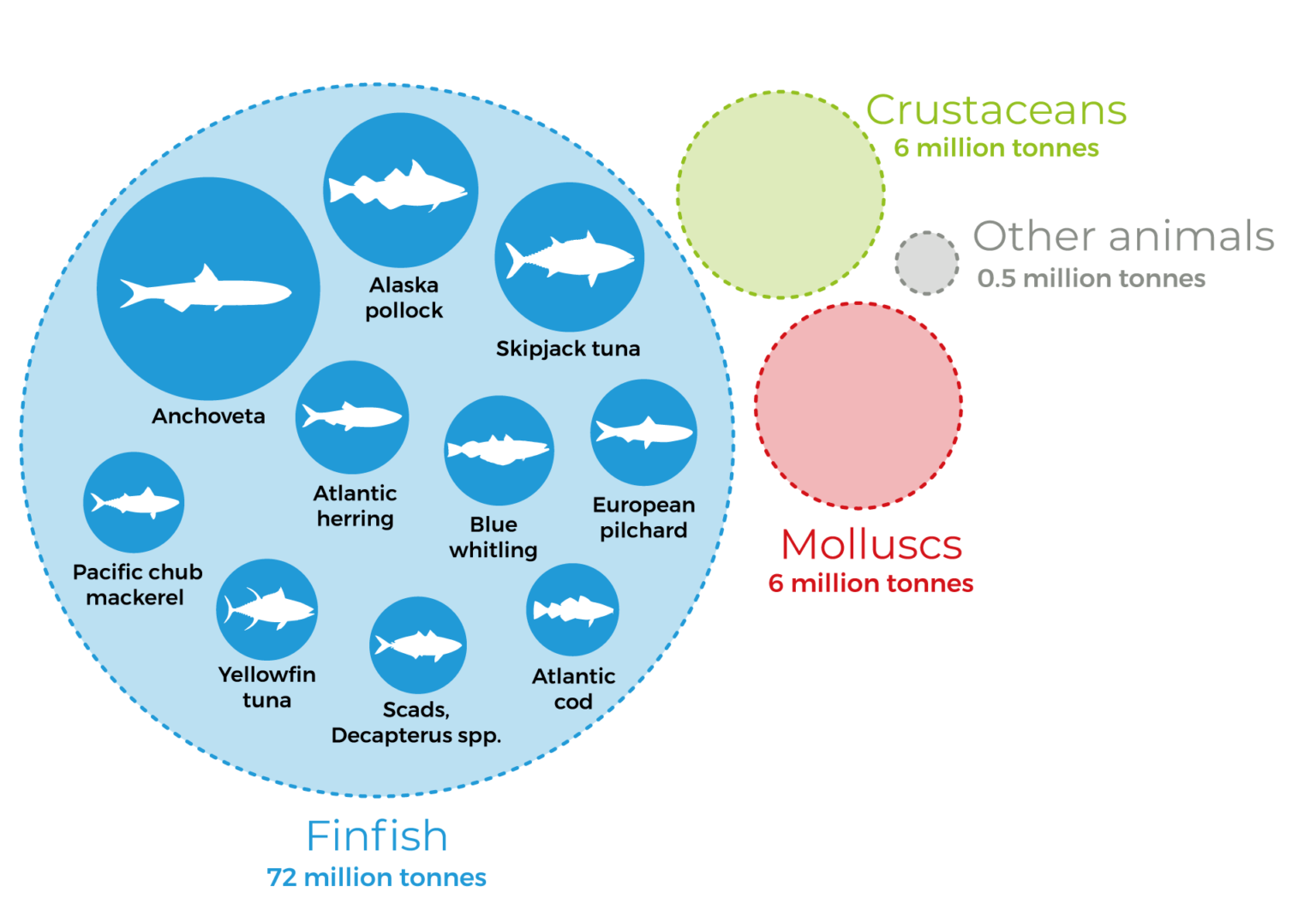 Figure 8: Global total marine wild capture production 2018: major groups and species. Source: FAO. 2020. The State of World Fisheries and Aquaculture 2020. Sustainability in action. Rome.
Figure 8: Global total marine wild capture production 2018: major groups and species. Source: FAO. 2020. The State of World Fisheries and Aquaculture 2020. Sustainability in action. Rome.
The recent EAT-Lancet Commission on healthy diets from sustainable food systems is one of many studies that strongly recommend we reduce red meat/animal protein production and consumption from terrestrial food sources. So, how can aquatic foods – from ocean and freshwater systems – secure more sustainable food futures?
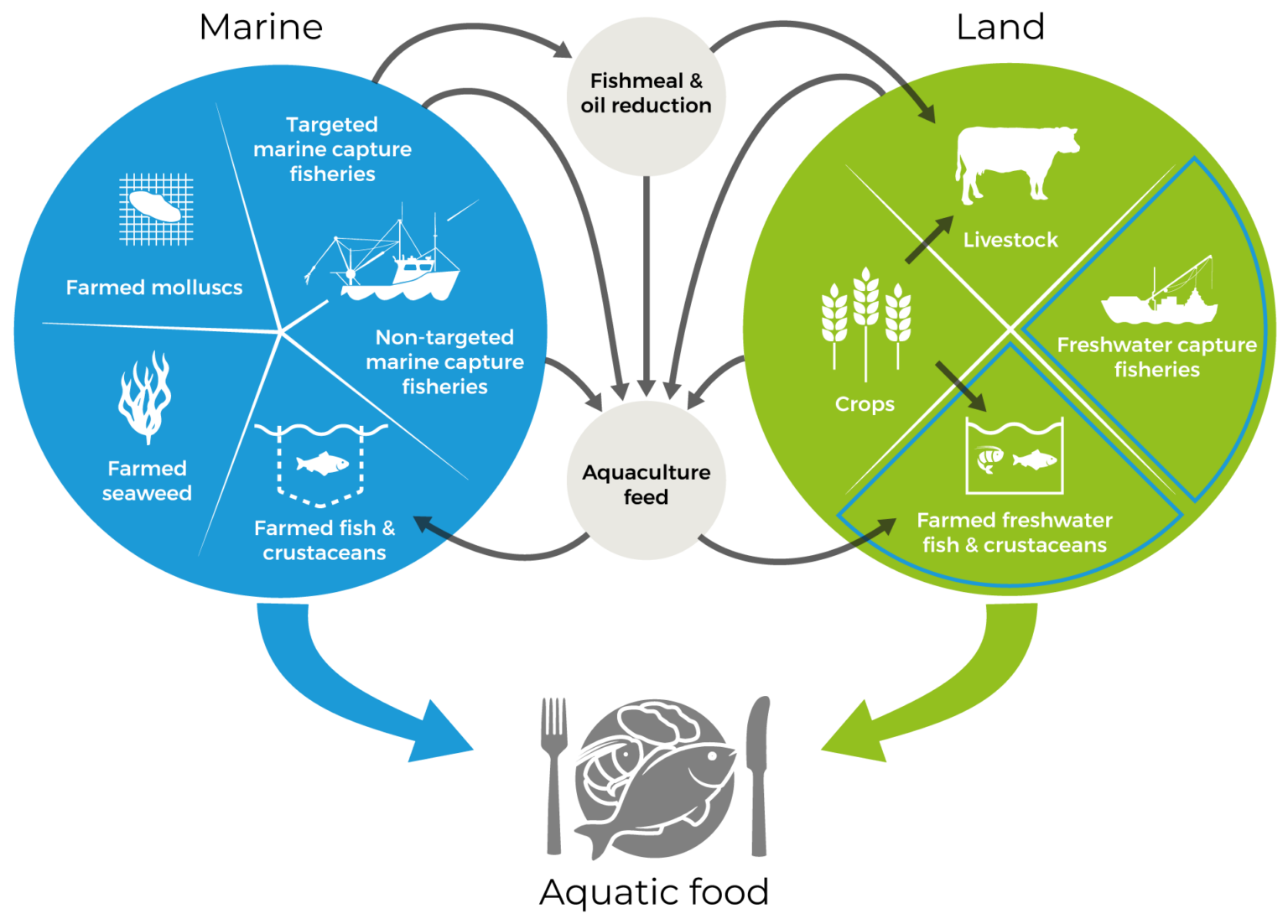 Figure 9: Land-Sea Interactions. Adapted from Naylor et al. (2021). A 20-year retrospective review of global aquaculture. Nature 591.
Figure 9: Land-Sea Interactions. Adapted from Naylor et al. (2021). A 20-year retrospective review of global aquaculture. Nature 591.
According to the Blue Food Assessment, which was officially launched in September 2021, there remains significant untapped potential. Aquatic foods are extremely diverse. We catch over 2,000 species and sub-species and farm over 425 different species across both freshwater and marine environments. However, a mere 23 species account for roughly 70% of today’s global blue food production. This still compares favorably with terrestrial production, where pork, beef, and poultry account for over 93% of protein from animals. Not all of these blue foods are equally nutritious; some species contain scant nutrients compared to other blue foods. An instructive example comes from Bangladesh, where a single serving of small indigenous fish provides five times as much vitamin B12 (an essential vitamin for healthy human development) as one serving of farmed tilapia. However, it is important to remember that even less nutrient-rich blue foods may still be a healthy replacement for red meat.
A key nutritional benefit of so-called blue foods is nutritional density and diversity. But this is often hidden when lumped together and “reduced to the protein (energy) value of a singular type of food: seafood or fish”. A large array of blue foods, integrated creatively into the global food system, can provide critical nutrients that are challenging to get elsewhere and improve health in general.
The paper linked above suggests there are three specific ways that food from the sea can better human health: 1) by reducing micronutrient deficiencies 2) by being the major source of omega-3 fatty acids that might reduce heart disease and bolster eye and brain health 3) by shifting consumption away from red and processed meats that are often less healthy and can cause heart disease and other wellness issues.
Is blue food for everyone?
“Around 260 million people worldwide are involved in marine fisheries either directly or indirectly, and many of these people depend on fisheries for both employment and nutrition”
In Bangladesh, aquaculture’s rapid and intensive development is already causing a shift from local fish to tilapia. Although this specific example concerns freshwater fish, there are many parallel examples. The nutrient quality of fishery landings (the part of the fish catch that is put ashore) is determined by the species composition rather than simply by the quality. Numerous high-nutrient marine species are thrown overboard as bycatch. Many countries further complicate the issue as they base their fisheries policies on providing large quantities of fish for international markets, primarily high-income countries.
An unintended consequence of this is that poorer, nutritionally deficient countries end up exporting nutrients while undermining their own food and nutritional security (as highlighted in the recent work of Hicks and colleagues). Namibia offers a stark example of this dynamic; a mere 9% of the fish caught in Namibian waters could satisfy dietary iron requirements for the entire coastal population. Yet, large portions of these coastal populations remain deficient in dietary iron as almost all fish caught in Namibian waters is exported.
Globally, aquatic foods contribute 17% of animal protein consumed, but this masks huge distributive differences that get to the heart of the inequity built into the global food system. In some countries, fish accounts for well over 50% of all animal protein consumed; for some communities, it is their only source of dietary protein and a nearly irreplaceable source of micronutrients. Many of the countries that are most reliant on fish protein are also the ones where millions depend on fisheries and coastal aquaculture for their livelihoods and cultural identities.
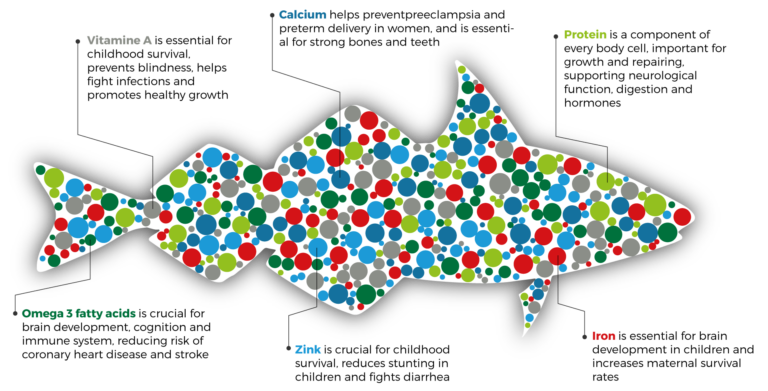 Figure 10: Fish remain an essential source of both protein and micronutrients and provide important health benefits. Adapted from: Troell M., & Jonell M. (2018) 'Seafood for Human and Planetary Health.' SeaBOS Stockholm Dialogue Background Brief.
Figure 10: Fish remain an essential source of both protein and micronutrients and provide important health benefits. Adapted from: Troell M., & Jonell M. (2018) 'Seafood for Human and Planetary Health.' SeaBOS Stockholm Dialogue Background Brief.
Blue foods’ future role is going to vary hugely across countries and cultures. The Swedish population, for example, already consumes large amounts of seafood. In Sweden, blue foods might help wean society off overconsumption of terrestrially sourced meat; it could be a stepping-stone toward healthier and more sustainable diets. Yet this may not be the desired endpoint.
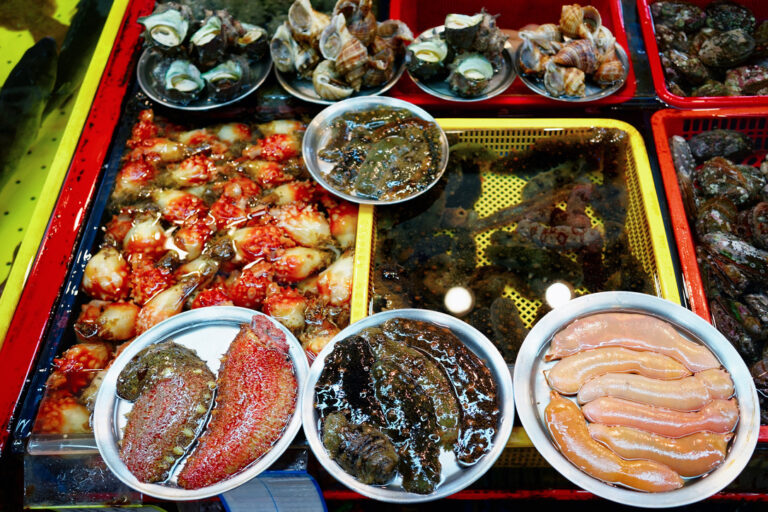 Fresh seafood in fish market in Busan, Korea. – Aquatic foods are extremely diverse. We catch around 2,000 species and sub-species and farm over 425 different species across both freshwater and marine environments. Photo: Getty
Fresh seafood in fish market in Busan, Korea. – Aquatic foods are extremely diverse. We catch around 2,000 species and sub-species and farm over 425 different species across both freshwater and marine environments. Photo: Getty
Blue foods could just add to an already overfull plate for some of us and make many more plates emptier in other parts of the world. Which blue foods, produced where, for whom, and in what quantities? These questions form a critical focal point for the future of the global food system.
Environment and health impacts
“Small pelagic fish and bivalves create the smallest footprints across capture fisheries and aquaculture respectively”
Seafood definitely compares favorably to some terrestrial protein sources, but this is not true of all blue foods. There are differences in both nutritional diversity and environmental footprint. Small pelagic fish and bivalves create the smallest footprints across capture fisheries and aquaculture, respectively. But we see significant biodiversity impacts from some wild-caught species. Emissions and pollution are also associated with certain forms of aquaculture, for example, the substantial use of sometimes highly ecologically valuable land, such as mangrove forests.
A newly published study provides a retrospective analysis of the last 20 years of developments within aquaculture, proving that a lot of progress has been made in growing volumes while reducing the use of small forage fish as a component in feeds. Global aquaculture volumes have tripled since 2000, with positive trends in environmental performance. Between 1997 and 2017, the annual catch of small forage fish used to make fishmeal and fish oil declined from around 23 million tons to 16 million tons. Simultaneously, the share of fishmeal used globally by the aquaculture sector (versus livestock and non-food uses) increased from 33% to 69%, and the share of fish oil grew from 55% to 75%. Consequently, there is still a high dependence on fishmeal and fish oil, contradicting claims that aquaculture production has become climate-friendly and less resource-intensive. However, this picture is complicated as small pelagic fish used in feeds and oils yield much lower greenhouse gas emissions than e.g., soybeans, a common replacement whose production is a substantial contributor to deforestation and associated greenhouse gas emissions.
The study also points out that many positive trends have been driven by economics rather than explicit sustainability efforts within the sector. For the past decade, using plant-based feed ingredients as the main aquafeed component has become substantially cheaper than using fish-based ingredients.
In some cases, aquafeeds have swapped one problem for another – or several others. Although crops used for aquafeeds constitute a minor portion of all crops, it is important to highlight that increased nutrient release into the ocean from intensive monocrop agriculture can lead to hypoxic dead zones. We don’t want to create a situation where we replace the over-exploitation of wild capture fisheries with aquaculture that contributes to starving the ocean of oxygen. In the future, we need to pay closer attention to the intimate relationship between land and sea in one integrated global food system.
Blue foods are by no means a silver bullet. Despite some prevailing narratives – notably many of those associated with the blue economy – we can only produce a finite amount of food from the oceans. We really need to ask what types of systems and species we should prioritize as the blue food production system expands. This is critical, given that the Blue Food Assessment projects global demand for blue foods will double (in terms of live weight) by 2050.
Beatrice Crona, Co-chair of the Blue Food Assessment, Professor and Deputy Science Director at the Stockholm Resilience Centre at Stockholm University, provides an elegant summary to conclude this chapter:
“Making sweeping, generalized statements prevents us from having intelligent, science-based conversations about the potentials of aquatic foods. Just like we differentiate between chicken, beef, and pork, we should distinguish between salmon, mussels, and herring because science shows us that they are very different across both environmental and nutritional dimensions… Prioritizing high nutrition, low impact blue foods means creating sufficient demand while reducing barriers for producers to deliver on this. Shifting demand is largely about consumer preferences, which involves changing ingrained cultural eating habits; no easy task. We must also adjust incentives for producers, conditioning investments to help steer them toward healthy and sustainable blue foods. Clearly, the investment community has a key role to play to achieve this.”
Marine Plants: the Swiss army knife of the ocean and a key to the future of our food system
Most often, when people think about food from the ocean, minds immediately turn to fish or perhaps shellfish, but rarely to plants. Indeed, the only exposure to aquatic plants many of us have had is the nori wrapped around sushi rolls, most likely filled with farmed salmon or “crab meat”, overcooked rice, and unripe avocado. However, just like fish and shellfish, the diversity of plant life flourishing in the ocean is immense. Indeed, most phytoplankton that are critical to primary productivity in the ocean and form the base of most marine food webs are plants.
Marine macrophytes, which include both seagrasses and seaweeds (macroalgae), are foundational for productive and diverse coastal ecosystems, delivering a wide array of ecosystem goods and services. Like many marine ecosystems, seagrass meadows and macroalgal forests are degrading rapidly and face a wide range of human pressures. One recent study that drew on over 200 earlier surveys estimates that seagrasses have declined annually at a rate of over 100 km² since 1980 and that these rates continue to accelerate. While macroalgal forests have been facing a similar, linear decline, a number of documented cases have proven that they are also suffering regime shifts and transforming quickly and irreversibly into sea urchin barrens with a corresponding and catastrophic loss in the ability to deliver a variety of ecosystem services. Two of the primary stressors putting pressure on these foundational ecosystems are slowly rising temperatures and the shock of marine heatwaves, which are increasing in frequency and severity. Interestingly, there is some initial experimentation in attempting to genetically “prime” seagrass meadows and seaweed forests to better respond to heat stress. Priming is a technique that has been used in crop agriculture but is yet to be applied widely in the context of marine plants.
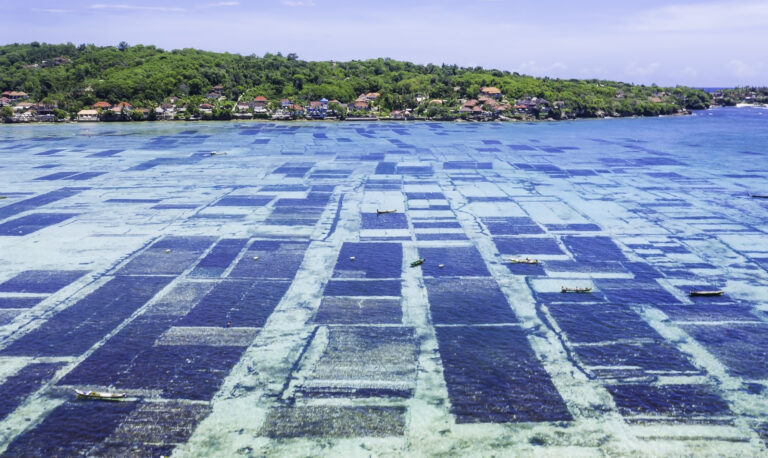 Nusa lembongan seaweed farming in Bali, Indonesia Photo: Getty
Nusa lembongan seaweed farming in Bali, Indonesia Photo: Getty
Human’s use of seaweed dates back centuries; its cultivation also has a long history, albeit of only a few species. Globally, the largest producers of seaweed are China and Indonesia. Together they produce over 23 million tons (as of 2014). Currently, seaweed farming’s increased annual growth rate exceeds 8% (FAO). While Portugal is one of the countries spearheading the sustainable production of seaweed and related products, Chile, China, and Norway are world leaders in harvesting it from the wild. Given its versatility, seaweed undoubtedly has untapped potential to become a cornerstone of a blue foods future – much like the ocean is, and can continue to be, a cornerstone of the global food system, even if it is not always recognized as such. There is tremendous belief in the potentially transformative impact of plant-based blue foods. The UN Global Compact, the United Nations organization focused on sustainable business, has released a Seaweed Manifesto that attempts to define a vision for the future development of a seaweed industry that can scale rapidly and responsibly and be an important contributor to ecosystem restoration.
To pour a bit of cold, salty water on this enthusiasm, it is worth noting that this focus on seaweed does present its own set of challenges. Currently, most algae are used for non-food purposes, i.e., as thickening agents. In addition, despite their potential nutritional value, there are question marks about the extent to which humans can effectively utilize nutrients in algae (known as a lack of bioavailability). There is also a significant flavor issue; algae’s palatability is most certainly a key barrier to meaningful human consumption. None of these are fatal for the role of marine plants in the future food system, but all are live scientific questions.
Marine algae as climate champions
A major reason for protecting and restoring both seagrass beds and macroalgal forests – besides their intrinsic value and importance as refuges and nurseries for other marine species – is that they play a relatively small but vital role in sequestering carbon. This could be expanded significantly. In fact, seaweed farming is the most rapidly growing segment of global food production, offering a portfolio of opportunities for both climate mitigation and adaptation. However, making the most of these opportunities will require active regeneration and restoration of seagrass beds and macroalgal forests, yet, such efforts have so far not been very successful, even as experimentation continues.
There is, of course, a tradeoff in simultaneously using algae for carbon capture and human consumption. It calls for significant investment in innovative thinking and solutions that intelligently combine the dual purpose of food and climate mitigation. Certain species in certain places would be for human/livestock consumption, and in other places, the focus would be on ecosystem restoration for climate mitigation and nature recovery.
With a mix of fanfare and skepticism, Orca, the first-ever commercial-scale carbon capture and storage plant, recently opened in Iceland. It cost around 15 million USD just to build and can absorb up to 4 000 tons of carbon per year when running at full capacity. By contrast, seaweed farms have an assessed carbon mitigation capacity of about 1 500 tons of CO2 per km² per year. In other words, protecting and restoring marine plant ecosystems is likely much more cost-effective, bringing many more co-benefits – in terms of ecosystem goods and services – than building a huge number of carbon capture and storage facilities. As is often the case, nature can still do many, many things much better than humans. Today, farmed seaweed captures only about 0.4% of the carbon that wild seaweed does; current estimates suggest that this could be increased to around 6%.
Apart from acting as a direct carbon sink, seaweed farming also has the potential to reduce emissions from terrestrial agriculture when used as a substitute for synthetic fertilizers and incorporated into cattle feed. Early evidence shows that even a small percent of seaweed can significantly reduce cattle’s methane emissions. Therefore, there is potential for marine plants to make terrestrial agriculture more sustainable or at least produce less greenhouse gas emissions. Seagrasses and seaweed forests also play an essential role in climate change adaptation as, like mangrove forests, they can dampen wave energy during storm surges and protect coastlines. They can also alleviate local and regional environmental stressors by altering ocean PH levels and providing oxygen, thereby combating both ocean acidification and deoxygenation to a limited extent. This, in turn, improves the marine environment and could increase the survivability of other marine species that are especially vulnerable to the effects of acidification and deoxygenation.
A rapidly evolving landscape and a new start-up ecosystem
There is a rapidly growing and diverse ecosystem of start-ups experimenting with ways to ensure that plant-based seafood becomes a crucial part of the future food system. Some are extracting compounds from seaweed species for a range of purposes, while others are growing seaweed for food products, gene-editing terrestrial plant species to grow in the ocean, or building novel algal biorefineries to produce biofuels with marine algae. Yet others are using plant-based ingredients to mimic animal protein seafood and developing seafood products in laboratories from stem cells or “immortalized cell lines”. WorldFish has produced a comprehensive report on “alternative seafood” that is either plant-based or synthesized from cells.
As in other parts of the global food system, gastronomy is spearheading the exploration of marine, plant-based food futures. Spanish Chef Ángel León has been investigating foods from the sea for 12 years at his avant-garde restaurant, Aponiente, in Cádiz. León’s latest project focuses on eelgrass (Zostera Marina) cultivation, having established several experimental “ocean gardens” that supply the restaurant with marine rice and provide its diner with unique culinary experiences.
Astonishingly, this flowering underwater plant produces edible, highly nutritious rice-like grains with twice the protein content of ordinary rice, containing omega-3 acids, a first for a cereal. The marine crop does not require fertilizers or chemicals as seawater circulation provides everything the plants need to grow. What’s more, the plant itself is very effective at carbon capture; in fact, eelgrass has proved to be significantly better at capturing carbon than the rainforest. WWF has estimated that eelgrass can absorb carbon 35 times faster than rainforests, highlighting in a recent report that seagrasses, in general, soak up around 10% of all the carbon absorbed by the oceans annually even though they only cover roughly 0.2% of the global seabed. Native to Europe but in severe decline due to human pressure, large tracts of seagrass are often cleared for coastal development.
Eelgrass could potentially be more productive and economically viable than land-based grains. Indeed, rice cultivation is extremely water-intensive, it often requires large amounts of synthetic chemicals and fertilizers, and it produces methane, a potent greenhouse gas.
At Aponiente, Chef León is looking beyond fine dining, using gastronomy as a way to usher in the future of marine grains and kickstart a race to cultivate eelgrass on a larger scale. By doing so, he and his team will restore vital marine ecosystems, provide a highly nutritious food source to millions of people, and sustain livelihoods in economically depressed areas of coastal southern Europe.
Agrisea is taking a somewhat different approach to marine grains. The Canada-based start-up aims to grow rice on manufactured islands that float just off coastlines. It has developed a gene-editing technique based on CRISPR technology to re-engineer particular rice varieties so that they can survive and thrive in ocean environments, using neither land nor freshwater. The concept could be vital as rising sea levels threaten many coastal communities that currently cultivate rice. The grain is a critical staple crop for millions of people, despite the resource-intensiveness of its terrestrial production. Critically, CRISPR-based gene editing avoids the brute force-GMO approach’s unpredictability and possibility for genetic escape. Agrisea has not only created rice that can flourish in the ocean but is also developing spatially optimized farming platforms that will work with wave motions and have root systems that can take up nutrients directly from the seawater. Given the size of the global ocean, the opportunity to rethink terrestrial food production through a more concerted integration of land and sea offers significant potential. There is, of course, more than one type of integration model.
Plants and animals are stronger together
In the final section of this chapter, it is vital to emphasize how blue foods and green-blue foods can be even more powerful together. Marine algae, along with bivalves such as mussels, are at the forefront of the potential for a blue food revolution and key to large-scale, sustainable aquaculture with a minimal environmental footprint. When bivalves and seaweed, along with aquaculture species such as finfish, are cultivated together in an integrated system, they can provide a range of ecosystem goods and services, including habitat for fish and marine invertebrates such as crabs, sea snails, mollusks, and more. The emerging, applied research field of marine aquaculture ecosystem engineering has been named “integrated multi-trophic aquaculture (IMTA)”.
Such systems can be a vital part of coastal habitat restoration, allowing the creation of refuges for different species facing the combined impact of human pressure on the global ocean. The integration of animal-based marine protein and marine plants facilitates the scaling of a closed system that will not lead to a spike in environmental impact or unexpected spillover effects if implemented smartly. Max Troell, a leading aquaculture scientist, notes that these systems hold promise for:
“…increasing significantly the sustainability of aquaculture, based on a number of potential economic, societal, and environmental benefits, including the recycling of waste nutrients from higher trophic-level species into the production of lower trophic-level crops of commercial value.”
A key benefit of IMTA is that it avoids the plague of intensive monocultures that have caused such immense problems, both in terrestrial farming systems and in scaling aquacultural production for species such as salmon.
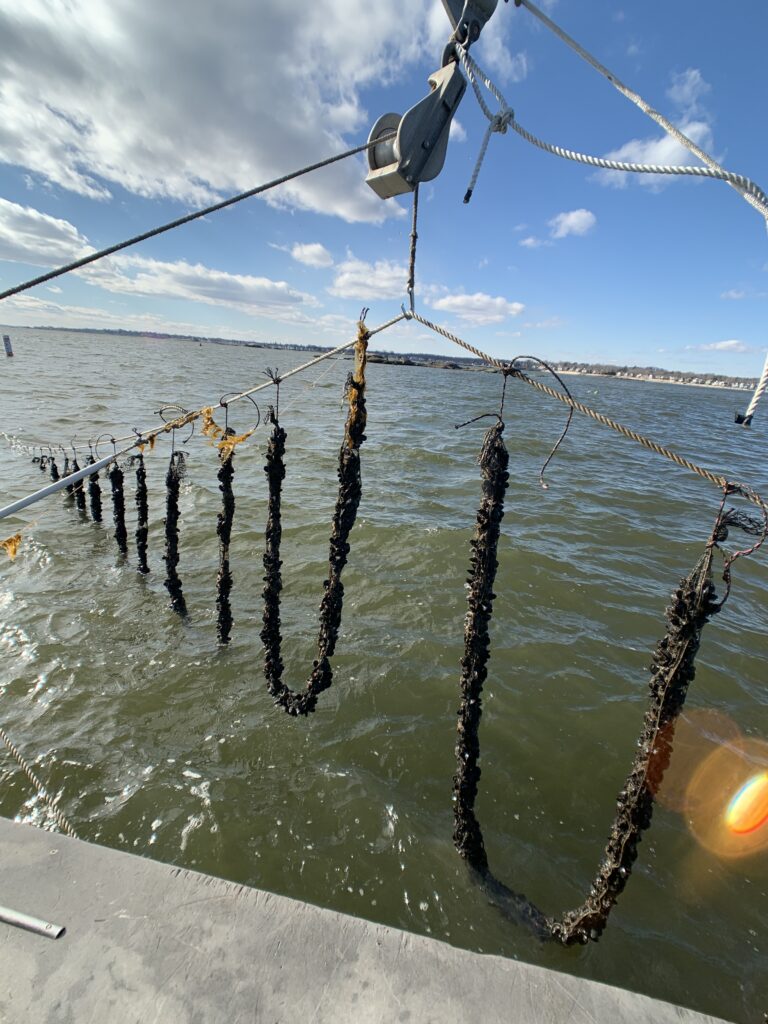 GreenWave’s regenerative ocean farming system grows a mix of seaweeds and shellfish that require zero inputs while sequestering carbon and rebuilding reef ecosystems. Photo: GreenWave
GreenWave’s regenerative ocean farming system grows a mix of seaweeds and shellfish that require zero inputs while sequestering carbon and rebuilding reef ecosystems. Photo: GreenWave
Marine plants are the foundation for today’s marine ecosystems. They could potentially play a small but crucial role in successfully transforming to a sustainable global food system on a healthy and resilient planet. They are a powerful, multifunctional tool that can be applied creatively to address the many challenges facing the ocean and the global food system.
Novel entities & new challenges: welcome to the world of plastic beaches, the reign of jellyfish, adaptable invaders, and metal-tainted tuna
“Beyond more well-known issues such as rising seawater temperatures and acidification, the ocean is facing numerous emerging novel threats that are all relevant for the ocean’s ability to being a cornerstone of the global food system”
Not only did the COVID-19 pandemic alter people’s lives and impact the global economy, but it also accelerated changes that had been happening slowly for years. As human activity keeps increasing the cumulative pressures on the ocean, emerging and novel threats will continue to arise and perhaps even trigger critical points that have yet to be identified. While these shifts might not have solely negative consequences, they will require entirely new ways of thinking about problems and identifying solutions. This links closely to the planetary boundary entitled “novel entities” – new compounds, situations, and threats that emerge from the close coupling of humans and nature as part of an intertwined social-ecological system.
Plastics, plague of the ocean
“Since the invention of plastic, humans have produced enough of it to equal over 500,000 blue whales, which is especially striking considering that the current population of blue whales is estimated to be around 5,000 individuals”
Marine plastic pollution is perhaps the quintessential “novel entity” afflicting the global ocean. Its implications are sure to continue generating surprises over the coming decades as cumulative human pressures build on the global ocean.
In the September 2019 issue of Nat Geo, Madeleine Stone describes pyroplastic “pebbles and stones” washing up on the shores of Britain’s southwest coastline. Transformed by fire, this newly defined form of plastic pollution may be hiding in plain sight all over the world, according to Andrew Turner, an environmental scientist at the University of Plymouth.
The story of plastic begins in 1907 with the invention of the word “plastic” and the world’s first synthetic polymer, “Bakelite”, both the brainchild of Leo Bakeland. Even as early as the 1930s, Bakelite was used in everything from jewelry to electronics. There have been three phases in the history of plastics. The first, which lasted until the 1950s, was characterized by invention and innovation; many of the commercial plastics used today originated then. The next phase, from the 1950s to the turn of the century, saw almost exponential growth in plastic production. Since then, in the third phase, growth in plastic production has slowed to circa 3-4% annually.
In 2019 alone, global plastics production was estimated at 367 million metric tons. Approximately 6,300 million metric tons have been produced since the invention of plastic, only 9% of which has been recycled. The rest has either been incinerated or ended up in landfills. A colossal chunk has also found its way into the oceans.
As an ocean-related analogy, a blue whale can weigh up to 146 metric tons. This means that since the invention of plastic, humans have produced the plastics’ equivalent of over 500,000 blue whales, which is especially striking considering that the current population of blue whales is estimated to be around 5,000 individuals. Plastic is utterly omnipresent in ocean and land-based industries, but the largest application – roughly 40% – is packaging, mostly single-use, a considerable amount of which is connected to the global food system.
The majority of the plastic that ends up in the ocean does so from land-based sources, predominantly from coastal regions and densely populated watershed areas. The massive rise of marine plastic pollution illustrates the close relationship between land and sea and confirms the need for harmonized governance systems across terrestrial and ocean systems.
A recent study showed that nearly half of all human-generated waste ends up in the ocean. The four biggest polluters are takeaway food items such as single-use bags, plastic bottles, food containers, and food wrappers. Due to their widespread use and exceptionally slow degradation, a mere ten plastic products, including fishing gear, account for three-quarters of the litter.
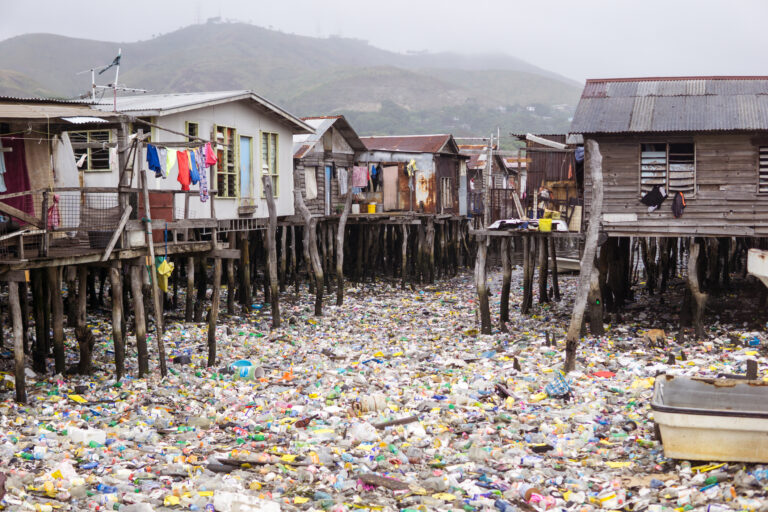 Plastic fantastic? A floating wooden village, surrounded by a sea of plastic refuse in Port Moresby, Papua New Guinea. Photo: Getty
Plastic fantastic? A floating wooden village, surrounded by a sea of plastic refuse in Port Moresby, Papua New Guinea. Photo: Getty
The durability of plastic, initially so desirable and useful, is the reason it has become an environmental liability. Biodegradation can take centuries. The process takes even longer in the ocean as most plastic pollution sinks and becomes coated with bacteria and algae.
But slow degradation does not prevent plastic from breaking into smaller pieces. Ocean currents and winds cause a highly variable distribution of ocean plastics, with concentrations along shorelines and within five subtropical systems of circulating currents – ‘gyres’ – on the open ocean. The infamous Great Pacific Garbage Patch is three times the size of France. Plastic litter has been found everywhere, including some of the most remote deep-sea trenches and polar regions. Estimated flows of plastic into the ocean are far larger than the amounts actually observed; it is believed that most of it sinks and is buried in seafloor sediments.
The threat of macro-, micro-, and nanoplastics
“Some plastics act almost like sponges, soaking up pollutants and concentrating them to levels of up to 1 million times the levels in surrounding environments. Although unpredictable, these pollutants can transfer to organisms when ingested”
Marine plastic pollution has three main types of impacts:
- Entanglement and ingestion – marine life entangled in macroplastics and/or ingesting plastic waste, causing, e.g., whales to beach themselves and die. Other species like sea turtles have also been found to either swallow plastic or become entangled in it. 90% of surveyed seabirds have been affected by plastic ingestion. Entanglement often involves abandoned, lost, or discarded fishing gear.
- Bioaccumulation – evidence that micro- and nanoplastics bioaccumulate within marine food webs, similar to other pollutants like mercury and PCBs. Some plastics act almost like sponges, soaking up pollutants and concentrating them to levels of up to 1 million times the levels in surrounding environments. Although unpredictable, these pollutants can transfer to organisms when ingested. Filter feeders like mussels have been found to accumulate microplastics. In one study, wild and farmed mussels destined for human consumption were compared; both were found to have over 100 microplastic filaments in their gills.
- Bioaccumulation in humans – the impacts of Bisphenol A on human health are still largely unknown. This organic synthetic compound, found in many plastic water bottles that end up in the ocean, is poorly soluble in water. When accumulated in humans, it displays estrogen-like properties and causes hormonal imbalances. Other additives are known to cause cancer. Bioaccumulation is of particular concern as humans consume seafood.
In line with the concept of “novel entities”, there are also several emerging threats from marine plastic pollution. Microplastics, for example, can act as stable substrates (surfaces that organisms can live on) within aquatic environments and have been linked to the spread of invasive species, sparking harmful algal blooms, jellyfish blooms, and the spread of antimicrobial-resistant bacteria. Equally disturbing, plastics could accelerate climate change; made primarily from fossil fuels, their breakdown in the ocean has been linked to the release of methane, which is up to 25 times more potent than carbon emissions into the atmosphere.
Menacing jellyfish desert blooms
“We are engineering an Anthropocene ocean that is much more ecologically beneficial to jellyfish than many other species. This is problematic as jellyfish are nutritionally poor compared to many of the species that they are outcompeting”
Jellyfish are not a novel entity; in many cases, they are an important part of healthy marine ecosystems. Even when they form dense blooms, they are a food source for over 150 species of fish, seabirds, and marine mammals. Actually, humans have consumed jellyfish for nearly 2,000 years; there are jellyfish fisheries in at least 18 countries, harvesting more than 1 million tons a year. In addition, jellyfish and their byproducts are used in various industrial applications, including cosmetics and pharmaceuticals.
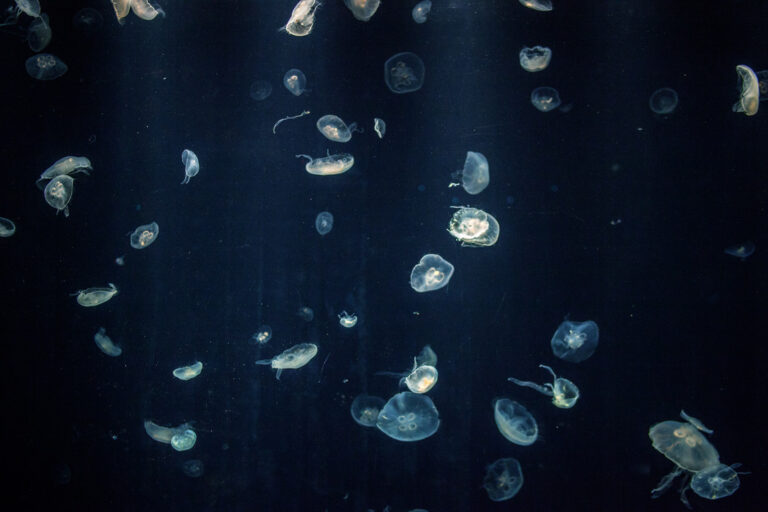 Jellyfish are not a novel entity; in many cases, they are an important part of healthy marine ecosystems. Photo: Getty
Jellyfish are not a novel entity; in many cases, they are an important part of healthy marine ecosystems. Photo: Getty
Many human pressures are engineering an Anthropocene ocean much more ecologically beneficial to jellyfish than other species. Because of their very particular set of skills, jellyfish can thrive in areas of the ocean impacted by overfishing and eutrophication, which can and has led to a largely irreversible shift to jellyfish-dominated ecosystems. In fact, this has been documented in the Black Sea.
One alarming intersection between plastics and the tenacious jellyfish is that marine plastics can act as stable substrates to which jellyfish polyps can attach. The abundance of plastic and the building of coastal infrastructure, such as piers, wharfs, and docks, afford jellyfish increased breeding success. This can potentially create conditions that could supercharge jellyfish blooms and has led some scientists to predict an ocean future characterized by “jellyfish deserts”. Says leading marine biologist Daniel Pauly, “My kids will tell their children: eat your jellyfish!”
While still quite unlikely, the prospect of more gelatinous marine systems is rather problematic as jellyfish are really very nutritionally poor compared to many of the species they are out-competing – a hyper-abundance of jellyfish is unlikely to generate a new marine protein source for the global food system. Those future grandchildren will have to eat a whole lot of jellyfish to get any significant nutritional benefit. Furthermore, jellyfish have been memorably described as a “trophic cul-de-sac”; they are both nutritionally poor and, despite being voracious feeders, incapable of transferring energy higher up in the food chain, which can have disastrous impacts on marine food webs already under heavy pressure.
Compounding this area of emerging concern, one recent study estimates that there have been significant increases in jellyfish biomass in 62% of the large marine ecosystems globally. While establishing jellyfish fisheries provides one way of managing jellyfish biomass, they are not always cost-effective or reliable. Only about 20 of the 1,400 species found worldwide are deemed suitable for consumption, processing jellyfish is labor-intensive, and stock sizes are unpredictable from year to year.
Recently, more extreme measures have been conducted to manage jellyfish blooms, among them, giant wire nets and science fiction like ‘JEROS’ jellyfish destroying robots, developed in South Korea and capable of shredding up to 900 kg of jellyfish biomass per hour.
Despite the speed of change, our ocean has a remarkable capacity to recover and repair if we can release some pressure and give it the time and space to do so. These emerging threats require radical, economic, and societal transformations along with groundbreaking technological innovation.
Mercury poisoning on our plates
In 1956, the first case of Minamata disease was discovered in the Kumamoto Prefecture of Japan. It grew to become an international scandal. Thousands of subsequent disease victims were considered casualties of the Japanese post-war, progress-at-all-costs economic development model. The cause of this horrific, debilitating disease was methylmercury (MeHg), released into the waterways by a local chemical factory. This toxic chemical accumulated in fish and shellfish that were harvested and eaten by local communities in Minamata Bay and the Shiranui Sea. The disease tormented the community for over 30 years, and it took a very long time for the problem to be officially recognized, let alone addressed. To this day, claims for compensation from the chemical company and the Japanese government are still being settled.
Methylmercury pollution is yet another persistent, organic ocean pollutant. Like microplastics, it can significantly bioaccumulate, severely impacting the health of humans and marine ecosystems. In a recent synthesis study focusing on the impact of mercury in a changing ocean, authors Colin Thackray and Elsie Sutherland illustrate why this novel entity matters in connection to the ocean as part of our global food system:
“MeHg is a neurotoxic contaminant found at varying concentration levels in all seafood. Its concentration in human blood is strongly tied to seafood consumption, with both type and amount of seafood consumed being relevant factors. It poses the greatest risk to children and fetuses, which has led WHO and others to recommend that children and pregnant women limit their consumption of high-mercury seafood such as swordfish, shark, and some varieties of tuna. Without access to alternatives, the Arctic populations of Inuit and Canadian First Nations people and coastal aboriginal people generally experience much higher than average exposure due to their marine mammal- and seafood-heavy diets.”
Mercury is found as an impurity in coal and is released into the atmosphere when burned. It is also a byproduct of many industrial processes involved in making chemicals, as witnessed in the Minamata disaster. The human contribution to environmental mercury levels is substantial.
Mercury is especially insidious in terms of its worldwide spread because it is subject to long-range atmospheric transport. The vast majority in the atmosphere – and now in ocean ecosystems – is anthropogenic.
In the ocean, inorganic mercury can be methylated by microbes and converted into an organic form that can then be bioaccumulated, making its way into food webs. Mercury in the ocean is only expected to increase in the forthcoming decades. Though how much of it is bioaccumulated in marine food webs is not known.
Methylmercury concentrations increase the further up the marine food web one moves; the longer the food chains, the higher the concentration. This is known as biomagnification. Rising ocean temperatures will increase MeHg bioaccumulation and further raise MeHg-levels in fish, becoming a mounting threat to human health.
Of course, MeHg is only one example of a persistent organic pollutant that impacts the marine environment. In the Baltic Sea, the primary sources of environmental toxins are dioxin and PCBs (polychlorinated biphenyls). Most of the dioxin comes from waste-burning incinerators, while PCBs stem from the chemicals industry. This has led health authorities, among others, the Swedish food authority, to recommend that people in risk groups, such as pregnant women and young children, consume fatty fish from the Baltic no more than 2-3 times a year.
Invasion of the biomass snatchers
Invasive species not only prey upon native species; they also take over their habitats, act as transport vectors for new diseases and parasites into vulnerable ecosystems, decrease water quality, and wreak havoc on nutrient cycles.
“The culinary world is stepping in and playing a key role in creating exciting gastronomic adventures around eating invasive species.”
A third set of novel challenges relate to the increasing prevalence of various invasive species. They threaten already strained marine ecosystems and spread infectious diseases that undermine the capacity for aquatic ecosystems to recover when key species are struck down by illness.
This is especially relevant to the food system as diseases and parasites – such as sea lice that afflict salmon farms – find it especially easy to thrive and spread when animals are packed closely together in intensive aquaculture production. Aquaculture has also contributed to the global rise of antimicrobial resistance because crowding large quantities of animals together requires enormous amounts of antibiotics to prevent the spread of bacteria.
The fisheries division of the U.S. National Oceanic and Atmospheric Administration (NOAA) considers the threat of invasive and exotic marine species and fisheries overexploitation to be major drivers of marine biodiversity loss. When the impact of invasive species is further combined with habitat destruction and climate change, the pressure on marine biodiversity becomes immense.
Because the oceans are the “lifeblood of global trade”, with gigantic container ships sending cars, electronic devices, fruit, soybeans, and frozen meat – and fish – all over the world, it is estimated that these ships transport around 7,000 species in their ballast water.
Invasive species are plaguing marine environments worldwide. Cannonball jellyfish have washed up on Florida beaches, and pacu, a close relative of the piranha (which has a largely undeserved, if fearsome reputation), has been spotted off the coast of Denmark. Crown of thorns starfish have laid waste to large swathes of the Great Barrier Reef, and Asian shore crabs dent populations of shellfish and lobster. Meanwhile, the glamorous, devastating lionfish continues to conquer new domains despite creative efforts to halt its spread.
These invasive species have severe environmental and economic impacts, making them an urgent problem to solve. Invasive species prey upon native ones that often play essential balancing roles in ecosystems; they take over habitats, reducing available space for native species while competing with them for all sorts of ecosystem resources. Furthermore, they can act as transport vectors for new diseases and parasites into vulnerable ecosystems. They cause smothering via rapid overgrowth, decrease water quality, wreak havoc on nutrient cycles and even, through hybridization and interbreeding, lead to genetic dilution of native species.
Here, the culinary world is stepping in, playing a pivotal role in creating exciting gastronomic adventures around eating alien species. The beautiful but deadly lionfish is the poster child for both invasive species and the role that chefs can play in combating its fast-growing dominance. This species (Pterois volitans) has a truly unmatched appetite; it can graze on over 50 different species and, in a comic book villain-like scenario, can increase its stomach volume to 30 times its normal size. These varied meals can then make up 90% of its body weight. The poisonous fish is remarkably adaptable, utterly insatiable, and has caused immeasurable devastation. As a deliberate strategy to combat its invasive success, chefs and divers have recently teamed up to create culinary delights and drive the creation of a global market for this ocean menace.
Another example is the Japanese Giant Oyster which is native to the pacific coast of Asia but now an introduced species in North America, Australia, New Zealand, and Europe. In Sweden, an experimental innovation project is underway to assess whether Japanese giant oysters might contribute to the profitability of Swedish mussel and oyster farms as part of a larger testbed for cultivating “foreign” or introduced species at sea. The project involves limiting the spread of Japanese giant oysters by finding ways to inhibit their propagation.
A final example is the red king crab invasion from Russia into Norway. Known locally as “Stalin’s red army”, it started in the 1980s and led to the almost-overnight creation of a highly lucrative fishery business built on this invasive species. Prior to the crabs’ arrival, existing cod fisheries had been depleted by overexploitation, and economic prospects were scarce. The new industry has also enabled better control of the spread of this fast-moving invader.
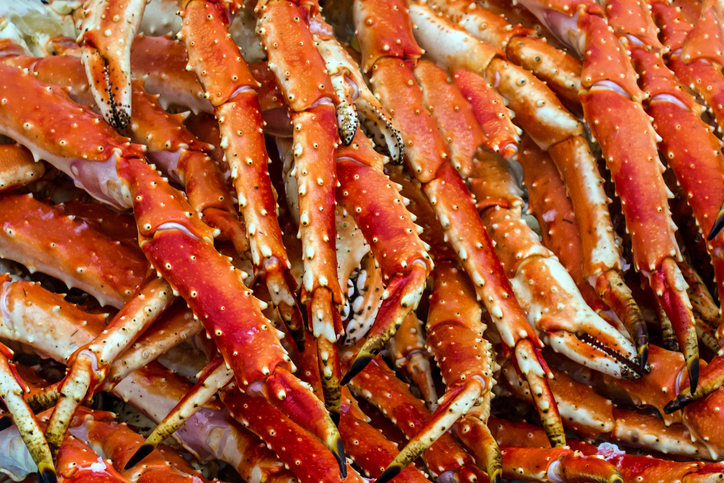 The invasion of king crabs from Russia created a lucrative industry in Norway. Photo: Getty
The invasion of king crabs from Russia created a lucrative industry in Norway. Photo: Getty
As reported in a topical New York Times feature, these are only a small selection of a large number of campaigns on land and in the oceans addressing the threat of invasive species. In 2011, conservation biologist Joe Roman launched the “Eat the invaders” initiative. So, if you’re wondering what you can do right now, head over to “Eat the Invaders” for a taste of the solution to the invasive species crisis. The array of “gourmet terrorists” you can choose from is quite astounding.
The deep ocean, the twilight zone and the high seas: the final frontiers of the final frontier
It is estimated that there are a total of more than 2.2 million marine species. The open ocean, the depths, and the twilight zone are all critically important areas to realize the ocean’s potential. There is a lot to explore, exploit – and safeguard.
Human ingenuity and demand for raw materials lead to continuous innovations that increase our ability to access natural resources. Technological advances and changing markets can consequently modify how humans interact with their environment, affecting both ecosystems and human wellbeing.
While the effects of such dynamics are evident in terrestrial and coastal ecosystems, it was long thought that the open oceans and the deep seas were too distant and vast to be affected in similar ways (as formulated in ‘‘The Freedom of the Seas’’; Grotius, 1609). However, the expansion of longline fisheries, effects of deep-sea fishing, and ocean acidification due to anthropogenic climate change, among many other factors, have led to concerns that human activities may instead highly impact such areas beyond national jurisdiction.
Since the 1950s, the international community has made steady progress in developing legal and governance instruments to manage the increasing number of stressors. The following section, in part, draws on the scientific paper “An Ocean of Surprises” It aims to assess the present and potential futures of open ocean areas beyond the jurisdiction of a single state.
Huge surface areas, massive depths
Large-scale movement patterns result in migratory marine species traveling across political boundaries on a regular basis. Eighteen marine predator species in the Pacific Ocean were found to visit 94% of the exclusive economic zones in the surrounding Pacific Ocean.
“The ocean beyond the continental shelf accounts for 64% of the planet’s surface. This ‘open ocean’ realm has more than twice the surface area of all terrestrial landmasses combined and nearly 170 times the habitable volume”
In the course of the second half of the 20th century, the greatest expansion of fishing efforts has, in spatial terms, occurred primarily beyond the limits of continental shelves – in Areas Beyond National Jurisdiction, ABNJ. The ocean beyond the continental shelf accounts for 64% of the planet’s surface. This pelagic or “open ocean” realm has more than twice the surface area of all terrestrial landmasses combined and nearly 170 times the habitable volume.
The impacts of fisheries, not just on open ocean species but also on open-ocean ecosystems, are becoming evident. Just because humans have created a boundary or a zone does not mean it has any connection to ecosystems. For example, the primary delineation of rights granted to nation-states – the so-called EEZs: Exclusive Economic Zones adjacent to coastal states’ territorial seas – are ecologically meaningless.
Migratory marine species regularly move across political boundaries. Research led by Daniel Dunn observed that; “Eighteen marine predator species in the Pacific Ocean were found to visit 94% of the EEZs in the Pacific Ocean and spent 14%-33% of their annual cycle in these waters and 53% to 76% of the time in the high seas.”
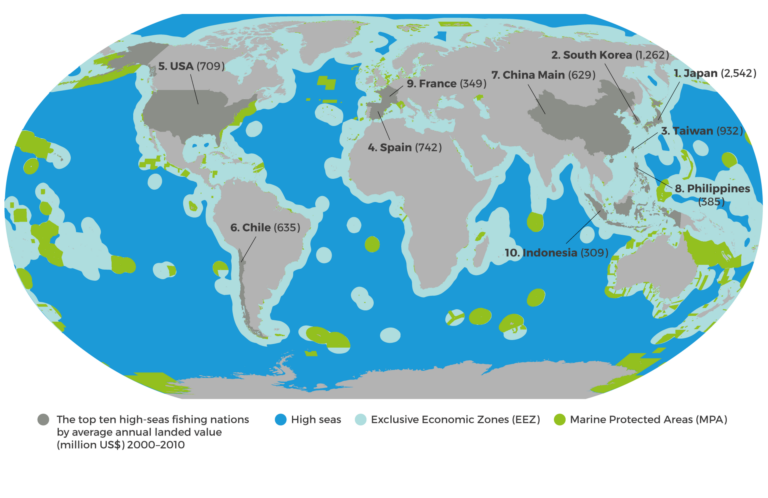 Figure11: High Seas fishing nations and global marine protected area networks. Adapted from Gaffney, O. 'Should Nations Close the High Seas to Fishing.'
Figure11: High Seas fishing nations and global marine protected area networks. Adapted from Gaffney, O. 'Should Nations Close the High Seas to Fishing.'
Overexploiting the last wild commons
South Korea, Japan, Spain, and Russia are key players in global fisheries overexploitation, especially in the high seas. In recent years, as in many other areas, China has risen to become a dominant player.
“Some estimates indicate that the size of China’s Pacific Ocean fishing fleet has grown by more than 500% since 2012. They are drawn here by tuna”
Despite growing arguments to significantly reduce high seas fishing activities, it is unlikely to happen as the ‘‘sunk cost’’ in capital investment such as ships and gear is repeatedly redirected to new species. The continuous exploitation coincides with illegal, unreported, and unregulated fishing through the emergence of “roving bandits”, a set of highly mobile units designed to prey on fishery resources quickly and efficiently. When a resource collapses in a particular place, or when the profit is no longer enough, they move to new areas and find new stocks to exploit.
States play a predominant role in this development. Recent work led by Enric Sala provides evidence that around 54% of all high seas fishing would be unprofitable without large government subsidies, estimated at approximately 4.2 Billion USD in 2014; Russia, Taiwan, and China operate with the most federal financial aid. South Korea, Japan, and Spain are also significant players in high seas fishing.
South Korea, Japan, Spain, Russia (and, before that, the Soviet Union) have long dominated global fisheries overexploitation, especially in the high seas. In recent years, however, China’s efforts have risen to prominence; the size of the Chinese distant water fishing fleet has grown dramatically. From 2000 to 2011, an estimated 3,000 vessels operated globally, swelling to more than 12,000 in 2017-2018 alone, according to the Overseas Development Institute’s calculations.
In the Pacific, China’s presence is striking. Estimates indicate that the nation’s Pacific Ocean fishing fleet has grown by more than 500% since 2012, drawn here mainly by tuna. The Pacific Ocean is one of the world’s most productive and diverse fishing grounds, supplying well over half of the world’s tuna. In 2019, the total tuna catch from the Pacific high seas beyond the EEZs was a record-setting 2,961,059 tons; 81% of the whole Pacific Ocean tuna catch and 55% of the global tuna catch.
Based on a survey of boats operating in the region, China commands more vessels than any other country. Hence, the ocean’s continued ability to sustainably provide fish for human consumption is ever more dependent on China and its decision-making and how it monitors and controls its vast fishing fleets outside its exclusive economic zone.
New deep-sea fishing technology leads to contagious exploitation
“Krill are already touted as a ‘miracle product’ for its fatty acids, sold as supplements and ingredients in advanced aquafeeds”
Beyond overexploitation, there is an emerging pattern coined “contagious exploitation” – the accelerated spread of exploitative practices across marine ecosystems, driven by the rapid development of deep-fishing technology.
This kind of expansion often comes with a limited biological and ecological understanding of the implications of such fishery practices. Krill, for example, is an important food source for several whale species, penguins, seals, and other ocean predators. Krill is still considered hyper-abundant, but rapid development of fishing technologies could quickly lead to overexploitation of krill stocks, threatening marine food webs.
 Rich in Omega-3 fatty acids, krill oil capsules are becoming a popular food supplement. Photo: Getty
Rich in Omega-3 fatty acids, krill oil capsules are becoming a popular food supplement. Photo: Getty
These dynamics have been observed in the ocean’s twilight zone, where both high-tech equipment and a significant increase in fishing depth are negatively affecting indigenous species. Deep-sea fishing is regularly conducted below 1,200 meters in every ocean basin. Fishing at such depths means the fisheries can simultaneously exploit shallow seamounts – areas rich in species and productivity, crucial for functioning deep-sea ecosystems. Disastrously, seamounts often contain seabed minerals such as cobalt, making them ripe for both deep-sea fishing and exploratory deep-sea mining. Thus, seamounts are a prime example of where multiple ocean industries interact and the critical need to determine how to “share the sea”.
New Zealand and Australia’s orange roughy (Hoplostethus atlanticus) deep-sea fishery illustrates how a technologically advanced fishing industry can quickly exploit a newly discovered resource in the face of lagging governance and limited biological knowledge. Earlier developments in deep-sea trawling technology-enabled intensive exploitation of newly discovered deep-sea stocks; the Soviet Union’s fishing fleets, specifically, developed substantial deep-sea technology. This kind of rapid “wildcat exploitation” resulted in the collapse of several orange roughy stocks before ecological knowledge was gained and effective management measures were established.
The allure of the twilight zone
“The ocean’s ‘twilight zone’, 200 to 1,000 meters deep, is home to a number of hyperabundant species that could prove to be an important contribution to a blue food future if harvested sustainably”
The recent emergence of mesopelagic myctophid fisheries – primarily for animal feed and represented by around 250 species known as ‘‘lanternfishes’’ – could create a “gold rush effect” and first-mover advantage for fisheries. Damaging exploitation of this new frontier may occur before we understand both the target species’ basic biology, the implications for non-target species, and the ecological interactions.
The ocean’s mesopelagic zone, known poetically – and scientifically accurately – as the “twilight zone”, is an area of limited scientific knowledge, at risk of human-caused degradation, species loss, and irreversible damage. It is home to numerous hyperabundant species that could significantly contribute to a blue food future if harvested sustainably.
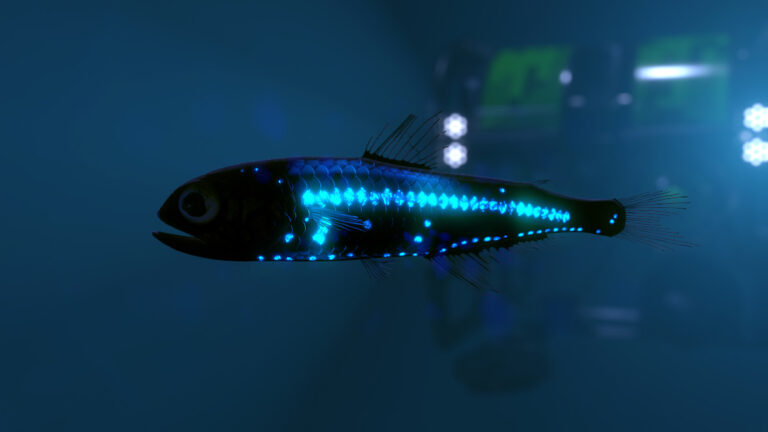 See you in the Twilight Zone! Lantern Fish, illuminated by an unoccupied underwater robot. Photo: Getty
See you in the Twilight Zone! Lantern Fish, illuminated by an unoccupied underwater robot. Photo: Getty
A recent appeal in Nature to study and protect the twilight zone describes the uniqueness of this layer of the global ocean:
“The twilight zone contains the world’s largest and least exploited fish stocks. Spanning from just below 200 meters to 1,000 meters deep, it is an interface between the well-studied marine life in the sunlit zone above and the ecosystems of the abyss below. This layer of the ocean is also home to the largest migration on earth. Countless fishes and zooplankton move hundreds of meters toward the surface each night to feed before retreating at dawn. This zone is very poorly understood – physically, biogeochemically, and ecologically. Very little is known about the organisms that live here, let alone their diversity and the unique ecosystem functions they perform.”
Given the overall levels of degradation that many parts of the global ocean face, the twilight zone remains relatively “untouched”. The majority of this zone is located in the “high seas” areas, and, alarmingly, it is beyond the jurisdiction and sovereignty of any single state. Still, there is evidence that this mysterious, monumental area is already under threat due to rising market demand for food and marine ingredients. This zone is also vulnerable to the ravages of climate change, including temperature fluctuations, decreased oxygen levels, and increased acidity that melts the shells and exoskeletons of ecologically important species.
As one can imagine, the twilight zone is hard to study, sparsely distributed, elusive and fragile, making it difficult to sample species, let alone conduct stock assessments for any accurate fisheries management system. What’s more, many ‘twilight zone’ native species also live at pressures of up to 100 atmospheres, which cannot be easily replicated and studied in a lab.
The authors of the aforementioned article in Nature describe one of the most unique and ecologically important but poorly understood features of the twilight zone, the biological carbon pump:
“Phytoplankton growing in the sunlit layer fuels multiple food-supply routes into the zone, sustaining organisms from bacteria to giant squid. While consuming this food and each other, the twilight zone residents produce CO2, consume oxygen, and release nutrients back into the water. In the winter, cold, windy weather mixes water containing the recycled nutrients with water from the surface layer. Although winter mixing can release carbon back into the atmosphere, a fraction of it ends up in deeper waters where it can be locked away, typically for centuries. Downward transport of organic matter, mediated by life in the mesopelagic zone – known as the biological carbon pump – and the twilight zone is central to its strength; however, how this actually happens is mostly unknown.”
Predicting future oxygen levels in the ocean is difficult as many complex factors are involved. Additionally, there are high levels of uncertainty about how organic carbon might be stored in the future. Both climate change and oxygen levels will impact how effectively the biological pump operates, but we don’t know how or to what degree.
“Fishing” for non-organic matter and novel biomaterials
“While deep-sea mining is one of the few instances where management regulations have been put in place before extraction activities begin, gold rush dynamics are still feasible”
Rapidly rising demand for high-tech products that require cobalt, e.g., solar panels, smartphones, and tablets, combined with uncertainty in the terrestrial supply, may substantially increase economic gains for extraction in the high seas. A breakthrough in autonomous mining robots or marine remote-operated vehicles could quickly shift the economics of deep-seabed mining and provoke accelerated expansion of mining activities.
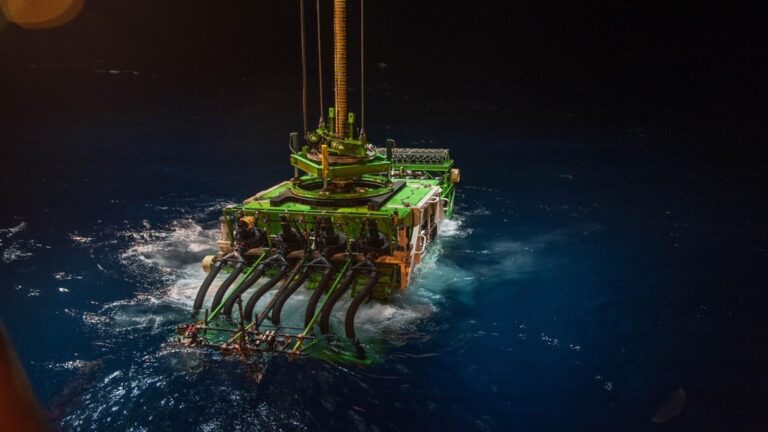 Patania II, a tracked, 25-ton subsea robot named after the world’s fastest caterpillar, here colleting rock-like nodules. rich in nickel, cobalt, manganese, and copper – during a scientific and environmental trial in the deep Pacific Ocean. Photo: Dema-group
Patania II, a tracked, 25-ton subsea robot named after the world’s fastest caterpillar, here colleting rock-like nodules. rich in nickel, cobalt, manganese, and copper – during a scientific and environmental trial in the deep Pacific Ocean. Photo: Dema-group
Recent developments indicate that such technological breakthroughs may be imminent. In 2020, Danish design firm Bjarke Ingels Group (BIG) partnered with “The Metals Company” to design robotic underwater vessels capable of mining polymetallic nodules on the seafloor. This type of mining can provide Rare-earth elements, increasingly in demand as the production of electric vehicles keeps growing.
While deep-sea mining is one of the few instances where management regulations have been put in place before extraction activities begin (by the International Seabed Authority), gold rush dynamics are still feasible. There are regulation gaps due to insufficient knowledge about ecosystem functions and the industry’s potential environmental impacts. We have little to no understanding of how mining will impact the biology and ecology of deep-sea ecosystems. In addition, a prolonged and severe shortage of highly sought-after minerals from terrestrial sources could prompt the industry to pressure the International Seabed Authority into relaxing regulations, allowing a gold rush scenario to emerge. What’s more, this destruction of vulnerable, unique, and poorly understood deep-ocean ecosystems could be completely unnecessary. Given the rapid growth of the EV (electric vehicle) market, current and massive R&D investments may eliminate the “need” for the deep-sea mining that many industry groups defend. Just last year, China achieved a breakthrough in the development of cobalt-free car batteries. And, in November 2021, the world’s first fully recycled lithium-ion battery was produced by Northvolt of Sweden.
Prospecting for marine genetic resources
“Beyond countries, some 13,000 marine genetic sequences are found in patents, and nearly half of these have been registered by just one corporation, German chemical company BASF”
Scientific research also supports the potential discovery of novel biomaterials that may be useful to the pharmaceutical, industrial, and biotechnology industries. Extreme temperatures, pressure, and the chemical composition of waters surrounding deep-sea hydrothermal vents result in unique biochemical conditions, well suited for a host of industrial uses that require thermo- and barostable (pressure) compounds or enzymes. These compounds can be used in diverse areas, from the food industry to biofuel and biopharmaceutical production.
Such bio-prospecting for marine genetic resources has raised concerns over access and benefit-sharing of genetic resources in areas beyond national jurisdiction. Only nations with well-developed research infrastructure will fully realize potential gains from marine genetic resources in areas beyond national jurisdiction, as they possess the technical capabilities to access these potentially deep and distant resources.
Although it is challenging to identify gene patents from organisms located solely in areas beyond national jurisdiction, examination of all marine gene patent claims reveals that ten countries account for the vast majority (>90%) of claims, with three countries (USA, Germany, Japan) submitting 70% of them. Subsequent research, led by Robert Blasiak, indicates that nearly half of all patents on marine gene patent sequences (from a total of around 13,000 marine genetic sequences targeted by patents) were registered by just one corporation, German chemical company BASF. Unlike fisheries and seabed mining, no international agreements exist specifically to regulate the identification, isolation, or patenting of marine genetic resources from areas beyond national jurisdiction, nor has it been determined what type of access regime will be implemented.
Developing countries consider the existing regime of an unregulated high seas freedom as highly unequal. They have advocated for equitable access and benefit-sharing of marine genetic resources, referring to the common heritage concept already applicable to mining in areas beyond national jurisdiction. Until an agreement is in place, biotechnology corporations, state- or privately owned, will continue to operate in this unclear governance context – profiting in some cases from the lack of benefit-sharing obligations, but perhaps also limiting their investments and research efforts due to regulatory uncertainty. Neither instance is aligned with aspirations of a sustainable and equitable ocean economy.
There is a lot to exploit: an estimated total of more than 2.2 million marine species. The open ocean, the depths, and the twilight zone are all critically important areas to realize the ocean’s potential while maintaining its capacity to provide a diverse array of benefits to the food system and humanity at large.
But we face rapidly escalating challenges as states and entrepreneurial firms probe exploitation frontiers in a governance vacuum, threatening to collapse and degrade these fragile, mysterious parts of the ocean before we even understand the nature of said potential.
Anticipating the future of our ocean: unpredictability, conflict, collaboration, and imagination. What happens when we jump off the precipice and cast ourselves into the future?
“The oceans can be seen not only as a new exploitation frontier but also as a new environmental security arena and probably a new battleground”
The ocean as a battleground – present and future conflicts over ocean resources
Given the blue acceleration’s increasing speed, disruptive global ocean and fisheries changes have sparked warnings of intensified fisheries conflicts driven by social, economic, and political factors. The oceans can be seen not only as a new exploitation frontier but also as a new environmental security arena – and perhaps a new battleground. To ensure a more sustainable future for our oceans and “the infinite fish” that can provide food for many generations to come, we must address and resolve conflicts and contradictions and expose the many incidents that occur out of sight of land.
Climate change can spur conflicts by causing changes in water temperature, ocean currents, and coastal upwelling patterns of marine systems, altering marine species’ distribution and potential yields. Shifts in species’ abundance and distribution, and consequently their catch potential, can compromise ocean security, by, for example, upending the governance and management of fish stocks.
 The Blue Justice Initiative supports the two Ministerial Declarations on Transnational Organized Crime in the Global Fishing Industry. One of their initiatives, Blue Enforcement, taches local coast guards how to stop organized fishing crime. Photo: The Blue Justice Initiative
The Blue Justice Initiative supports the two Ministerial Declarations on Transnational Organized Crime in the Global Fishing Industry. One of their initiatives, Blue Enforcement, taches local coast guards how to stop organized fishing crime. Photo: The Blue Justice Initiative
Aside from reducing fish catches and inciting competition over fish, overfishing can also directly escalate illegal, unreported, and unregulated fishing, which has led to an increasing array of conflicts ranging from diplomatic disagreements to violent clashes. Moreover, the seafood industry is only one of many sectors expanding its activities in the ocean, where disputes over food, material, and space could potentially mount among diverse ocean actors.
Climate change – a security threat
“Climate change is projected to disrupt fishery management even in well-organized democracies, making fishery conflict more likely in areas that otherwise exhibit fewer social, economic, and political stressors, as has been the case in the North-East Atlantic mackerel conflict”
There is increasing evidence of climate change impacts on marine systems. However, the degree of exposure to these impacts varies significantly across countries and regions. Recent research led by Jessica Spijkers shows how conflict plays out very differently in different parts of the world:
“Low-quality governance, pre-existing ethnic tensions, and increasing local demand for seafood are just some of the pressures that can collectively shape a region’s sociopolitical and economic profile and lead to fishery conflict. Some of the identified driving variables are global trends in diverse areas of our hyperconnected world.”
Climate change is projected to disrupt fishery management even in well-organized democracies, making fishery conflict more likely in areas that otherwise exhibit fewer social, economic, and political stressors. The North-East Atlantic mackerel conflict is an illustrative example. It traces back to 2007 when the North-East Atlantic mackerel suddenly shifted northward, igniting a clash between Iceland, the European Union (EU), Norway, and the Faroe Islands over the allocation and size of fishing quotas. And while the dispute continues, stocks are likely to shift more and create further conflict.
Conflict as a driver of transformation
“Low-intensity, non-escalating conflict can be productive by raising awareness, pushing public debate, generating new norms and institutional structures, and contributing to stronger cooperation”
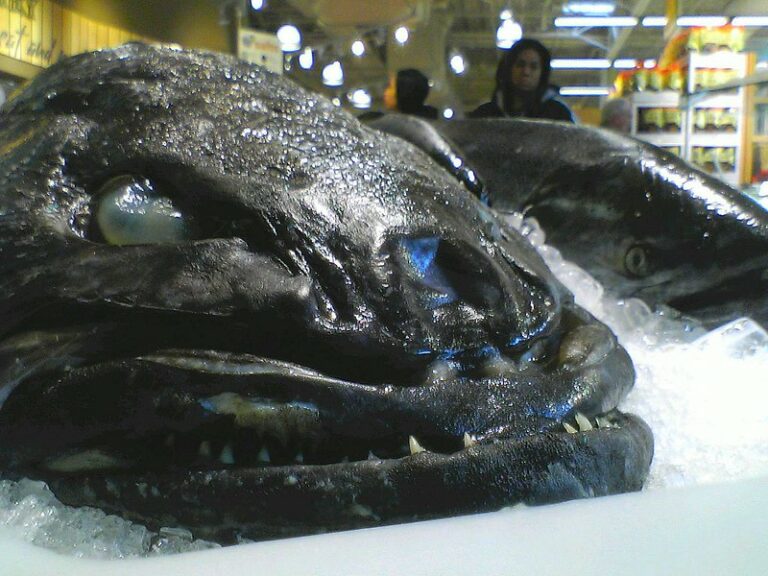 Chilean Seabass, or Tooth Fish – a truly remarkable prehistoric fish, in a US supermarket. Photo: Mike McCune, Flickr
Chilean Seabass, or Tooth Fish – a truly remarkable prehistoric fish, in a US supermarket. Photo: Mike McCune, Flickr
As we reflect on the future of our ocean in relation to the global food system, we must remember that fishery conflict does not always lead to undesirable societal outcomes. Confrontations can generate opportunities to transform marine social-ecological systems; such was the case with the toothfish crisis in the Southern Ocean. Ultimately, it resulted in effective compliance measures and substantial reductions in illegal fishing, as toothfish was extensively and unlawfully fished in the Southern Ocean. Sold as “Chilean seabass”, this truly remarkable prehistoric fish, dating from around the time of the dinosaurs, can reach lengths of over 2 meters and weigh 100 kilograms; it is ugly beautiful and highly prized. A coalition of fishing companies, conservation organizations, and government agencies joined forces to establish the Coalition of Legal Toothfish Operators. Over a decade of intense cooperation, they managed to drastically reduce the species’ overfishing, even leading to the successful prosecution of vessel owners who had previously acted with impunity.
Conflict can force players to the table and generate momentum for entirely new kinds of solutions, away from incremental thinking. Low-intensity, non-escalating conflict can effectively raise awareness, push public debate, and incubate social justice movements.
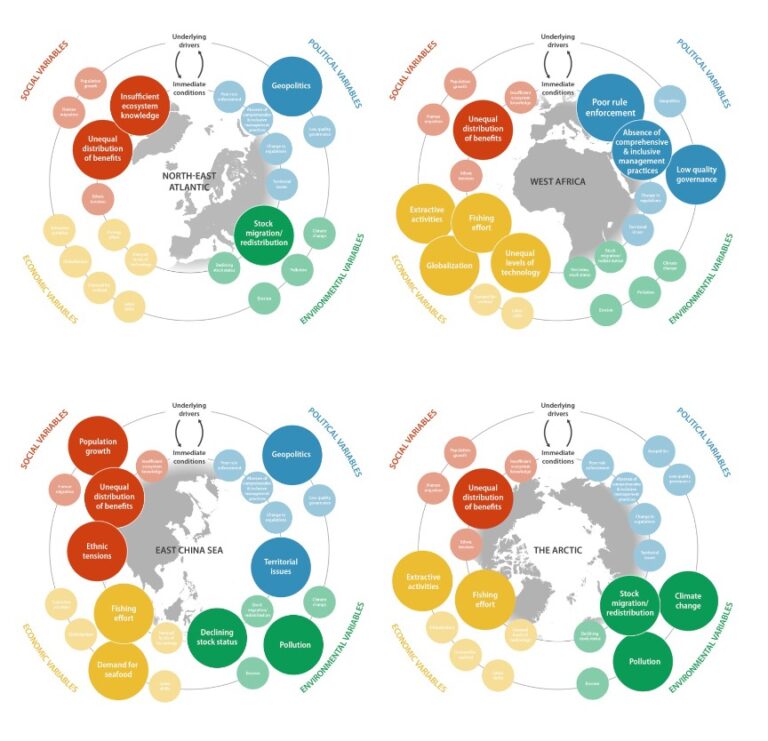 Figure 12: Amplified drivers and variables for four different future fisheries conflict scenarios. Reproduced with permission from Spijkers et al. (2020). 'Exploring the future of fisheries conflict through narrative scenarios.' One Earth
Figure 12: Amplified drivers and variables for four different future fisheries conflict scenarios. Reproduced with permission from Spijkers et al. (2020). 'Exploring the future of fisheries conflict through narrative scenarios.' One Earth
The blue acceleration continues to gather pace as a diverse group of actors aggressively push to exploit the ocean as the final frontier. When their interests, values, and economic incentives rub against each other, and the ocean becomes a site of geopolitical power and economic opportunity, the ocean will become more crowded, and conflict will further escalate. To anticipate these developments, it is crucial that we actively explore alternative futures and understand how today’s oceanic changes will manifest themselves tomorrow. Doing so will increase the chances for the ocean to remain a foundational contributor to the global food system and an agent of its sustainable transformation.
Scenarios, imagination, and the future ocean
“Stories are powerful things: they create our reality as much as they explain it. The futures we envision, be they positive or futures of collapse, make us much more likely to respond to events in the world in a way that helps create that future.”
– Alex Evans, The Myth Gap: What happens when evidence and arguments aren’t enough?Humans use stories as teaching and survival tools. Imagination is essential to social, cultural, and technological development. Our capacity to imagine can help us overcome the challenges we face today – the same challenges that our imagination created yesterday.
Planning for the future of our ocean and addressing the threats facing our global food system is a significant endeavor. It will impact lives everywhere, and, as such, it should not leave room for fiction of any kind. Certainty must come from measuring and monitoring.
Yet, science and its toolbox of methods and practices that provide “certainty” are limited if we cannot extrapolate and experiment with what they mean for the possible future. Call them predictions from models or scenarios – they are fiction until they become real. And before they become real, we have the chance to play with them to see if they are what we want.
In the context of looking to the future, a scenario can be described as “a coherent, internally consistent and plausible description of a potential future trajectory of a system”. Building scenarios can be an essential tool for proactively thinking about and acting to anticipate things to come.
Scenarios can help individuals, communities, corporations, and nations to develop a capacity for dealing with the unknown and the unpredictable, or the unlikely but possible. Military and corporate strategists have long used scenarios in planning processes. Royal Dutch Shell used a “scenarios approach” in the 1970s to help the company avoid the worst oil crises. War games are a type of scenario playing out. In 2016, U.S. military planners began running war games incorporating different climate change scenarios while focusing on “geopolitical and socioeconomic instability” linked to extreme weather patterns. Governments use them as a tool to support policymaking in the field of natural resource management. And the Intergovernmental Panel on Biodiversity and Ecosystem Services (IPBES) is increasingly adopting a scenarios approach.
When considering climate change, the Paris Agreement’s recently settled targets to cut back on greenhouse gas emissions rely on estimated future trajectories, given different pathways for carbon emissions. Created by the Intergovernmental Panel on Climate Change (IPCC), these may be the best-known examples for natural systems scenarios.
The IPCC’s business-as-usual scenario is hardly an engaging narrative. What would this future be like for those of us who might have to live in it? In scientific scenarios, analytical tools and techniques, combined with dull descriptions, almost always win out at the expense of storytelling, metaphors, and creativity that can evoke the readers’ imagination.
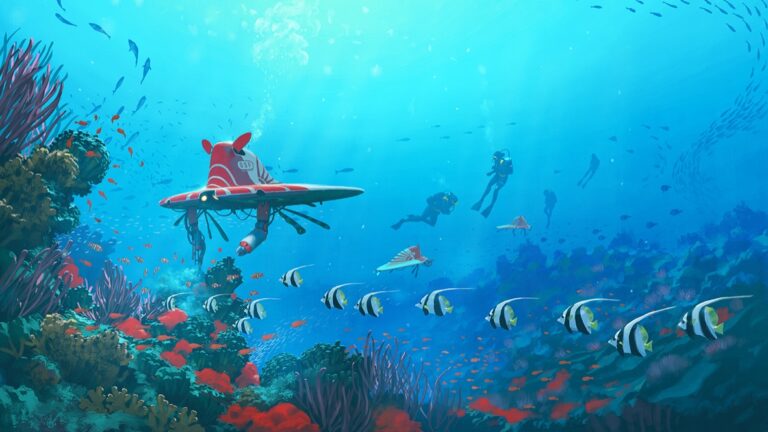 “Oceans Back from the Brink” by Simon Stålenhag, part of the Radical Oceans Futures project. This image shows healthy oceans back from the brink of disaster, with healthy ecosystems and well-managed fisheries. This scenario even has robots working to clean up the ocean and restore coral reef ecosystems. A coming together of human ingenuity and ecologically literate technology. Image: Simon Stålenhag/Radical Ocean Futures
“Oceans Back from the Brink” by Simon Stålenhag, part of the Radical Oceans Futures project. This image shows healthy oceans back from the brink of disaster, with healthy ecosystems and well-managed fisheries. This scenario even has robots working to clean up the ocean and restore coral reef ecosystems. A coming together of human ingenuity and ecologically literate technology. Image: Simon Stålenhag/Radical Ocean Futures
How then do we put this concept into practice? How can one weave together science and storytelling in a way that is both reliably credible and narratively compelling? Radical Ocean Futures, a science fiction prototyping approach to imagining our future oceans, developed by the author and colleagues, provides one such example. The heart of the project consists of four short stories about unlikely but possible ocean futures that combine science with creative speculation. The narrative scenarios were created following sci-fi prototyping methods to illustrate what lies ahead for fisheries and food.
The value of these imaginative approaches is not to attempt supplanting the critical scientific work of “predicting the future ocean” but rather to provide a robust complementary set of tools that enables scientists, policymakers, and others to engage with plausible and complex futures. Rethinking the future of our food system requires reimagining it in a way that connects science, policy, and practice with creativity, imagination, play, and speculation.
This approach to scenarios can contribute to building anticipation and response capacities in marine science, governance, and management organizations and, more normatively, for those seeking to change the world for the better.
 “Fish Inc” shows the logical extreme of ideas around “the blue economy” and “farming the seas”. The ocean has become a place for factories; a large tank is filled with jellyfish being turned into nutrient pastes. Image: Simon Stålenhag/Radical Ocean Futures
“Fish Inc” shows the logical extreme of ideas around “the blue economy” and “farming the seas”. The ocean has become a place for factories; a large tank is filled with jellyfish being turned into nutrient pastes. Image: Simon Stålenhag/Radical Ocean Futures